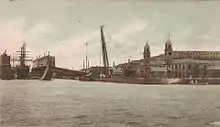War of 1812
The War of 1812 was a conflict fought between the United States and its allies, and the United Kingdom of Great Britain and Ireland and its dependent colonies in North America and indigenous allies. It began when the United States declared war in June 1812, and ended in a restoration of the pre-war status quo when a peace treaty agreed to earlier was ratified by the United States in February 1815. Historians in the United Kingdom often see it as a minor theatre of the Napoleonic Wars, while historians in North America see it as a war in its own right; it is related to the American Indian Wars, Sixty Years' War, Creek War, Tecumseh's War, and the American Revolutionary War.
| War of 1812 | |||||||||
|---|---|---|---|---|---|---|---|---|---|
| Part of the American Indian Wars and Sixty Years' War | |||||||||
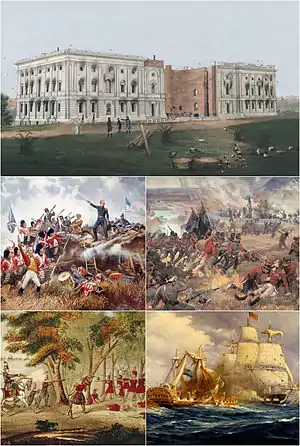 Clockwise from top:
| |||||||||
| |||||||||
| Belligerents | |||||||||
| Commanders and leaders | |||||||||
| |||||||||
| Strength | |||||||||
Allies |
Allies | ||||||||
| Casualties and losses | |||||||||
|
Allies
| ||||||||
| |||||||||
From the American perspective, the major casus belli of the war was the kidnapping of American citizens to man the Royal Navy, a practice known as impressment. Between 1793 and 1812, the British absconded with more than 15,000 American citizens and forced them to help the British prosecute their ongoing wars on the European continent.[10]
The Treaty of Paris, signed in 1783, ended the American Revolution by formally acknowledging the USA to be a sovereign nation separate and independent from Great Britain. The Americans felt greatly aggreived that their hard-won sovereignty was already being violated a mere 10 years after the Treaty's enactment by the mass Shanghaiing of their citizens to fight in another country's wars. One of the 27 colonial grievances enumerated in the Declaration of Independence directly highlights the practice of impressment, so the issue had already been politically sensitive even before the Revolutionary War broke out, and stopping it formed one of the primary motivations for achieving independence in the first place.[11]
Although begun well before the outbreak of war between the UK and Napoleonic France in 1803, the practice greatly accelerated under wartime conditions. Additionally, the Royal Navy enforced a naval blockade to choke off neutral trade to France, which the United States contested as illegal under international law.
As the kidnappings continued, American sentiment toward the United Kingdom grew increasingly hostile, exacerbated by incidents such as the 1807 Chesapeake–Leopard affair. Meanwhile, the British were outraged by the 1811 Little Belt affair.[12] The United Kingdom supplied arms to Native Americans, who raided European-American settlers on the American frontier, hindering the expansion of the United States and provoking resentment.[13]
The Canadian perspective on the war has been preoccupied primarily with whether America secretly yearned to add the remainder of the British colonies in North America to their fold - a different sort of unfinished work from the Revolution. While examination of some primary documents suggests that American maneuvers during the war were calculated simply to win the war expeditiously,[14] other historians have read expansionist motives into them.
President James Madison signed into law the declaration of war after heavy pressure from the War Hawks in the United States Congress.[15] Federalist opposition to the War of 1812 in the United States affected its prosecution, especially in New England, where it was referred to as "Mr. Madison's War".
With most of its army in Europe fighting Napoleon, the United Kingdom adopted a national-level siege strategy, focused on blockading the ports and containing the US at its borders, with offensive operations initially limited to the border and the western frontier, with help from its Native American allies. American military defeats at the Siege of Detroit and the Battle of Queenston Heights thwarted attempts to seize Upper Canada, improving British morale. American attempts to invade Lower Canada and capture Montreal also failed.[16] In 1813, the United States won the Battle of Lake Erie, gaining control of the lake and defeating Tecumseh's Confederacy at the Battle of the Thames, thereby defeating the United Kingdom's largest Native American ally, a primary war goal. The Americans made a final attempt to invade the Canadas, but the Battle of Lundy's Lane during the summer of 1814 was fought to a draw. At sea, the powerful Royal Navy cut off trade[17] and allowing the British to raid the coast at will. In 1814, the British burned Washington, but the Americans later repulsed British attempts to invade New York and Maryland, ending invasions from the Canadas into the northern and mid-Atlantic states. In early 1815, after a peace treaty had been signed, but before this news had reached the Americas, United States forces heavily defeated the attacking British Army near New Orleans, Louisiana with an estimated casualty count of 2,000 to 60.[18] This was viewed as restoring national honor and catapulted American commanding General Andrew Jackson to national celebrity, culminating in him being elected President in 1828. Fighting also took place in West Florida, where a two-day battle for the city of Pensacola ended in Spanish surrender.[19]
In the United Kingdom, there was mounting opposition to wartime taxation and merchants lobbied for the resumption of trade with the United States. With the abdication of Napoleon, the United Kingdom's war with France ended and the UK stopped impressment generally. This long-awaited cessation of American sailor impressment removed one of the original causes of the war. The British then increased the strength of their blockade of the United States coast which had a crippling effect on the American economy.[17][20] Peace negotiations began in August 1814 and the Treaty of Ghent was signed on 24 December 1814. The treaty was unanimously ratified by the United States Senate on 17 February 1815, ending the war with no boundary changes[21][22] except for the disposition of some islands in Passamaquoddy Bay, an issue that was resolved after the war.[23]
A curious thing about the historiography of this war is that all sides claim to have won it, and to an extent, this is true, as every belligerent essentially got what they most wanted. The British were able to vanquish Napoleon (twice, as it turned out) and quickly forgot about the War of 1812; it is viewed as a minor theatre of the Napoleonic Wars in the UK and overshadowed by key victories at the Battle of Trafalgar in 1805 and Waterloo in 1815 which led to the Pax Britannica. In the United States and Upper Canada, nationalistic mythology around the war took hold following its conclusion, however. The Canadians emphasize their ability to remain separate from the United States, with the failure of the invasion of British Canada advancing the evolving concept of Canadian identity and of Canada as a distinct region that would continue to evolve into a nation.[24] And the Americans were able to finally end the impressment of their citizens and enforce their sovereignty. Both the restoration of honour and the "Second War of Independence" are important themes in American historiography and are considered significant results by historians.[25][26][27]
Indigenous nations are generally understood to be the primary losers in the war.
Origin
| Origins of the War of 1812 |
|---|
Historians have long debated the relative weight of the multiple reasons underlying the origin of the War of 1812.[28][29][30][31]
Honour and the second war of independence
As Norman K. Risjord notes, a powerful motivation for the Americans was the desire to uphold national honour in the face of what they considered British insults such as the Chesapeake–Leopard affair.[32] H. W. Brands writes: "The other war hawks spoke of the struggle with Britain as a second war of independence; [Andrew] Jackson, who still bore scars from the first war of independence, held that view with special conviction. The approaching conflict was about violations of American rights, but it was also about vindication of American identity".[26] Some Americans at the time and some historians since[25] have called it a "Second War of Independence" for the United States.[27]
At the same time, the British were offended by what they considered insults, such as the Little Belt affair. This gave them a particular interest in capturing the American flagship President, an act that they successfully realized in 1815.[33]
Impressment and naval actions
In 1807, Britain introduced a series of trade restrictions via the Orders in Council to impede neutral trade with France, whom they were fighting in the Napoleonic Wars. The United States contested these restrictions as illegal under international law.[34] Historian Reginald Horsman states that "a large section of influential British opinion [...] thought that the United States presented a threat to British maritime supremacy".[35] The United States Merchant Marine nearly doubled between 1802 and 1810. During the Napoleonic Wars, it became the world's largest neutral fleet.[36]
The United States' view was that Britain's restrictions violated its right to trade with others. Britain was the largest United States trading partner, receiving 80 percent of American cotton and 50 percent of other American exports. The British public and press resented the growing mercantile and commercial competition.[37]
During the Napoleonic Wars, the British Royal Navy expanded to 176 ships of the line and 600 ships overall, requiring 140,000 sailors to man them.[38] The Royal Navy could man its ships with volunteers in peacetime, but it competed in wartime with merchant shipping and privateers for a small pool of experienced sailors. Press gangs were employed within Britain and so it turned to impressment from its shores and from foreign and domestic shipping when it needed manpower.
The United States believed that British deserters had a right to become American citizens, but Britain did not recognize a right for a British subject to relinquish his citizenship and become a citizen of another country. The British Navy considered any American citizen subject to impressment if he was born British. American reluctance to issue formal naturalization papers and the widespread use of unofficial or forged identity or protection papers among sailors[39] made it difficult for the Royal Navy to tell Americans from non-Americans and led it to impress some Americans who had never been British. Some of these gained their freedom on appeal.[40]
The Admiralty estimated that there were 11,000 naturalized sailors on United States ships in 1805 and United States Secretary of the Treasury Albert Gallatin stated that 9,000 American sailors had been born in Great Britain or Ireland.[41]
American anger grew when British frigates were stationed just outside American harbours in view of American shores to search ships and impress men within the United States territorial waters.[42] Well-publicized impressment actions outraged the American public such as the Leander affair and the Chesapeake–Leopard affair.[43][44]
The British public were outraged in their turn by the Little Belt affair in which a large American ship clashed with a small British sloop, resulting in the deaths of 11 British sailors. While both sides claimed that the other fired first, the British public in particular blamed the United States for attacking a smaller vessel, with calls in some newspapers for revenge.[45][46] Americans were encouraged by their victory over the Royal Navy.[47] The United States Navy also forcibly recruited British sailors, but the British government saw impressment as commonly accepted practice and preferred to rescue British sailors from American impressment on a case-by-case basis.[48]
British support for Tecumseh
The Northwest Territory consisted of Ohio, Indiana, Illinois, Michigan and Wisconsin. It was the battleground for conflict between the United States and various tribes.[49] The British Empire ceded the area to the United States in the Treaty of Paris in 1783, both sides ignoring the fact that the land was inhabited by various Native American peoples, including the Delaware, Fox, Kickapoo, Miami, Sauk, Shawnee, Winnebago and Wyandot people.
Some warriors left their tribes to follow Tenskwatawa, a Shawnee prophet and the brother of Tecumseh. Tenskwatawa had a vision of purifying society by expelling the American settlers, referred to as the "children of the Evil Spirit".[50] Tecumseh's Confederacy, an alliance of various indigenous people with Tecumseh at its head, wanted to create its own state in the Northwest as it became clear that the Americans wanted all of the land in the Old Northwest for national growth.[51] The British saw Tecumseh's Confederacy as a valuable ally and a buffer between their Canadian colonies and the United States, so they provided them with arms and ammunition. Subsequent attacks on American settlers in the Northwest further aggravated tensions between Britain and the United States.[52] Raiding grew more common in 1810 and 1811. Westerners in the United States Congress found the raids intolerable and wanted them permanently ended.[53][54] Additionally, Britain and the Native Americans had a long tradition of alliances against the United States, going back to the American Revolutionary War.[55]
British policy was divided. On the one hand, they wanted to encourage the raids to keep the Americans tied up fighting in the Northwest and also wanted to preserve a region that provided rich profits for Canadian fur traders. On the other hand, they feared that too much support for the tribes would cause a war with the United States.[51] Tecumseh's plans for an indigenous state in the Northwest would have made British North America more defensible, but the defeats suffered by his Confederacy made the British wary of too much support for what was probably a losing cause. British diplomats attempted to defuse tensions on the frontier in the months preceding the war.[51]
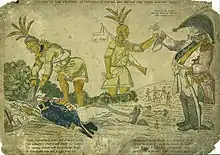
Tecumseh's Confederacy's raids hindered American expansion into rich farmlands in the Northwest Territory.[56] Pratt writes:
There is ample proof that the British authorities did all in their power to hold or win the allegiance of the Indians of the Northwest with the expectation of using them as allies in the event of war. Indian allegiance could be held only by gifts, and to an Indian no gift was as acceptable as a lethal weapon. Guns and ammunition, tomahawks and scalping knives were dealt out with some liberality by British agents.[57]
According to the United States Army Center of Military History, the frontiersmen had no doubt that their troubles with the tribes "were the result of British intrigue"[58] and many settlers began circulating stories of British Army muskets and equipment found on the field after raids. Thus, "the westerners were convinced that their problems could best be solved by forcing the British out of Canada".[59]
The British wanted to create a large Indian barrier state to cover much of Indiana, Michigan and Ohio. They made the demand as late as the fall of 1814 at the peace conference, but they lost control of western Ontario in 1813 at key battles on and around Lake Erie. These battles destroyed Tecumseh's Confederacy, which had been their main ally in that region, weakening their negotiating position. Although much of the area remained under British or British-allied tribal control until the end of the war, the British dropped the demands during the treaty negotiations.[60][61]
American expansionism
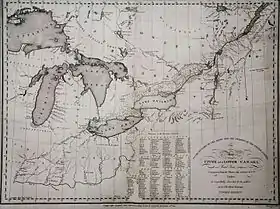
American expansion into the Northwest Territory had been obstructed by various Native American peoples since the end of the Revolution, with supplies and encouragement from the British. Americans on the western frontier demanded that the British cease the practice.[62] In June 1812, United States Secretary of State James Monroe said "[i]t might be necessary to invade Canada, not as an object of the war but as a means to bring it to a satisfactory conclusion". Speaker Henry Clay repeated the same argument.[63]
Canada was the only British possession that the Americans could easily attack and capturing it could force Britain to back down on maritime issues. As historian J. C. A. Stagg observed, it would also cut off food supplies for Britain's West Indian colonies and temporarily prevent the British from continuing to arm their indigenous allies.[64][65] However, some historians believe that a desire to annex Canada was a cause of the war.[64][66][67][68][69] Congressman Richard Mentor Johnson told the United States Congress that the constant Indian ambushes along the Wabash River in Indiana were enabled by supplies from Canada and were proof that "the war has already commenced".[70] He said that "I shall never die contented until I see England's expulsion from North America and her territories incorporated into the United States".[70]
Madison believed that British economic policies were harming the American economy because they were designed to bolster British trade. He also believed that Canada was a conduit for American smugglers undercutting his own trade policies, which could require the United States to annex British North America.[71] Furthermore, Madison believed that the Great Lakes–St. Lawrence trade route might become the main trade route for the export of American goods to Europe. If the United States controlled the resources of British North America, such as the timber that the British needed for their navy, then Britain would be forced to change the maritime policies that had so offended American public opinion.[71] Congressman John Adams Harper said in a speech that "the Author of Nature Himself had marked our limits in the south, by the Gulf of Mexico and on the north, by the regions of eternal frost".[71]
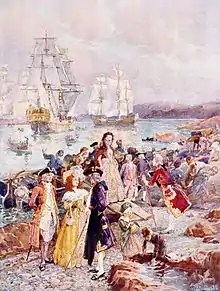
Upper Canada (southern Ontario) had until then been settled mostly by Revolution-era exiles from the United States (United Empire Loyalists) or postwar American immigrants. The Loyalists were hostile to union with the United States while the immigrant settlers were generally uninterested in politics and remained neutral or supported the British during the war. The Canadian colonies were thinly populated and only lightly defended by the British Army. Americans believed that Upper Canada would greet an American army as liberators, but American forces retreated after one successful battle inside Canada in part because they could not obtain supplies from the locals.[72] The Americans thought that the possibility of local support suggested an easy conquest as Thomas Jefferson believed: "The acquisition of Canada this year, as far as the neighborhood of Quebec, will be a mere matter of marching, and will give us the experience for the attack on Halifax, the next and final expulsion of England from the American continent".[73]
Some American border businessmen supported annexation because they wanted to gain control of Great Lakes trade.[74] Carl Benn notes that the War Hawks' desire to annex the Canadas was similar to the enthusiasm for the annexation of Spanish Florida by inhabitants of the American South as both expected war to facilitate expansion into long-desired lands and end support for hostile tribes (Tecumseh's Confederacy in the North and the Creek in the South).[75] Tennessee Congressman Felix Grundy considered it essential to acquire Canada to preserve domestic political balance, arguing that annexing Canada would maintain the free state-slave state balance that might otherwise be thrown off by the acquisition of Florida and the settlement of the southern areas of the new Louisiana Purchase.[76] Both John Adams Harper and Richard Mentor Johnson also saw the war as a divine plan to unify the two countries, with Johnson being particularly overt.[77]
Historian Richard Maass argues that the expansionist theme is a myth that goes against the "relative consensus among experts that the primary U.S. objective was the repeal of British maritime restrictions". He says that scholars agree that the United States went to war "because six years of economic sanctions had failed to bring Britain to the negotiating table, and threatening the Royal Navy's Canadian supply base was their last hope". Maass agrees that expansionism might have tempted Americans on a theoretical level, but he finds that "leaders feared the domestic political consequences of doing so", particularly because such expansion "focused on sparsely populated western lands rather than the more populous eastern settlements". However, Maass notes that many historians continue to believe that expansionism was a cause.[78]
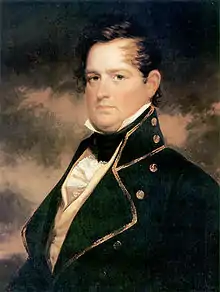
Reginald Horsman sees expansionism as a secondary cause after maritime issues, noting that many historians have mistakenly rejected expansionism as a cause for the war. He notes that it was considered key to maintaining sectional balance between free and slave states thrown off by American settlement of the Louisiana Territory and widely supported by dozens of War Hawk congressmen such as Henry Clay, Felix Grundy, John Adams Harper and Richard Mentor Johnson, who voted for war with expansion as a key aim. However, Horsman states that in his view "the desire for Canada did not cause the War of 1812" and that "[t]he United States did not declare war because it wanted to obtain Canada, but the acquisition of Canada was viewed as a major collateral benefit of the conflict".[79] Horsman says:
In disagreeing with those interpretations that have simply stressed expansionism and minimized maritime causation, historians have ignored deep-seated American fears for national security, dreams of a continent completely controlled by the republican United States, and the evidence that many Americans believed that the War of 1812 would be the occasion for the United States to achieve the long-desired annexation of Canada. [...] Thomas Jefferson well summarized American majority opinion about the war [...] to say "that the cession of Canada [...] must be a sine qua non at a treaty of peace."[79]
Horsman noted the ambiguity of President Madison, who on one had said the war was not about annexation of Canada, but then also said that once acquired, it may be hard to give up.[80]
Historian Alan Taylor says that many Democratic-Republican congressmen such as John Adams Harper, Richard Mentor Johnson and Peter Buell Porter "longed to oust the British from the continent and to annex Canada". A few Southerners opposed this, fearing an imbalance of free and slave states if Canada was annexed. Anti-Catholicism also caused many to oppose annexing the mainly Catholic Lower Canada, believing its French-speaking inhabitants unfit "for republican citizenship".[81] Even major figures such as Henry Clay and James Monroe expected to keep at least Upper Canada in an easy conquest. Notable American generals such as William Hull issued proclamations to Canadians during the war promising republican liberation through incorporation into the United States. General Alexander Smyth similarly declared to his troops when they invaded Canada that "you will enter a country that is to become one of the United States. You will arrive among a people who are to become your fellow-citizens".[81] However, a lack of clarity about American intentions undercut these appeals.[81]
David and Jeanne Heidler argue that "most historians agree that the War of 1812 was not caused by expansionism but instead reflected a real concern of American patriots to defend United States' neutral rights from the overbearing tyranny of the British Navy. That is not to say that expansionist aims would not potentially result from the war".[82] However, they also argue otherwise, saying that "acquiring Canada would satisfy America's expansionist desires", also describing it as a key goal of western expansionists who, they argue, believed that "eliminating the British presence in Canada would best accomplish" their goal of halting British support for tribal raids. They argue that the "enduring debate" is over the relative importance of expansionism as a factor, and whether "expansionism played a greater role in causing the War of 1812 than American concern about protecting neutral maritime rights".[67]
American political conflict

The United States was in a period of significant political conflict between the Federalist Party (based mainly in the Northeast) and the Democratic-Republican Party (with its greatest power base in the South and West). The Federalists were criticized by the Democratic-Republicans for being too close to Britain while the Federalists countered that the Democratic-Republicans were allied to France, a country headed by Napoleon, who was seen as a dictator. The Federalist Party favoured a strong central government and closer ties to Britain while the Democratic-Republican Party favoured a smaller central government, preservation of states' rights (including slavery), westward expansion and a stronger break with Britain. By 1812, the Federalist Party had weakened considerably and the Republicans were in a strong position, with James Madison completing his first term of office and control of Congress.[83]
Support for the American cause was weak in Federalist areas of the Northeast throughout the war as fewer men volunteered to serve and the banks avoided financing the war. The negativism of the Federalists ruined the party's reputation, as exemplified by the Hartford Convention of 1814–1815, and the party survived only in scattered areas. By 1815, there was broad support for the war from all parts of the country. This allowed the triumphant Democratic-Republicans to adopt some Federalist policies, such as the national bank, which Madison re-established in 1816.[84][85]
Forces
American
Although not much of a threat to Canada in 1812, the United States Navy was a well-trained and professional force comprising over 5.000 sailors and marines.[86] It had 14 ocean-going warships with three of its five "super-frigates" non-operational at the onset of the war.[86] Its principal problem was lack of funding, as many in Congress did not see the need for a strong navy.[87] The biggest ships in the American navy were frigates and there were no ships-of-the-line capable of engaging in a fleet action with the Royal Navy.[88] On the high seas, the Americans pursued a strategy of commerce raiding, capturing or sinking British merchantmen with their frigates and privateers.[89] The Navy was largely concentrated on the Atlantic coast before the war as it had only two gunboats on Lake Champlain, one brig on Lake Ontario and another brig in Lake Erie when the war began.[90]
The United States Army was initially much larger than the British Army in North America. Many men carried their own long rifles while the British were issued muskets, except for one unit of 500 riflemen. Leadership was inconsistent in the American officer corps as some officers proved themselves to be outstanding, but many others were inept, owing their positions to political favors. Congress was hostile to a standing army and the government called out 450,000 men from the state militias during the war.[90] The state militias were poorly trained, armed, and led. The failed invasion of Lake Champlain led by General Dearborn illustrates this.[91] The British Army soundly defeated the Maryland and Virginia militias at the Battle of Bladensburg in 1814 and President Madison commented "I could never have believed so great a difference existed between regular troops and a militia force, if I had not witnessed the scenes of this day".[87]
British
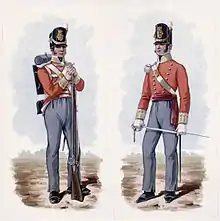
The United States was only a secondary concern to Britain, so long as the war continued with France.[90] In 1813, France had 80 ships-of-the-line and was building another 35 and containing the French fleet was the main British naval concern.[90] In Upper Canada, the British had the Provincial Marine. While largely unarmed,[92] they were essential for keeping the army supplied since the roads were abysmal in Upper Canada.[90] The Royal Navy had two schooners on Lake Ontario and the St. Lawrence while the Provincial Marine maintained four small warships on Lake Ontario and three on Lake Erie.
When the war broke out, the British Army in North America numbered 9,777 men[93] in regular units and fencibles (units raised locally on the same terms as regulars). While the British Army was engaged in the Peninsular War, few reinforcements were available. Although the British were outnumbered,[90] the regulars and fencibles were better trained and more professional than the hastily expanded United States Army.[94] The militias of Upper Canada and Lower Canada were initially far less effective,[90] but substantial numbers of full-time militia were raised during the war and played pivotal roles in several engagements, including the Battle of the Chateauguay.
Indigenous fighters
The indigenous allies of the British avoided pitched battles and relied on irregular warfare, including raids and ambushes that took advantage of their knowledge of terrain. Their leaders sought to fight only under favourable conditions and would avoid any battle that promised heavy losses. The indigenous fighters saw no issue with withdrawing if needed to save casualties. They always sought to surround an enemy, where possible, to avoid being surrounded and make effective use of the terrain.[95] Their main weapons were a mixture of muskets, rifles, bows, tomahawks, knives and swords as well as clubs, bows and melee weapons, which sometimes had the advantage of being quieter than guns.[96]
Native Americans fighting with United States forces provided them with the "most effective light troops"[97] while the British needed indigenous allies to compensate for their numerical inferiority. In addition, they were highly mobile, able to march 30–50 miles a day.[95] The highly decentralized bands and tribes considered themselves allies of, and not subordinates to, the British or the Americans. Their leaders did what they thought best for their tribes, much to the annoyance of both American and British generals.[98]
Declaration of war

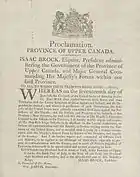
| Wikisource has original text related to this article: |
On 1 June 1812, President James Madison sent a message to Congress recounting American grievances against Great Britain, though not specifically calling for a declaration of war. The House of Representatives then deliberated for four days behind closed doors before voting 79 to 49 (61%) in favour of the first declaration of war. The Senate concurred in the declaration by a 19 to 13 (59%) vote in favour. The conflict began formally on 18 June 1812, when Madison signed the measure into law. He proclaimed it the next day.[15] While the Authorization for Use of Military Force Against Iraq Resolution of 1991 was a closer vote, it was not a formal declaration of war. This was the first time that the United States had declared war on another nation and the Congressional vote was the closest vote in American history to formally declare war.[99][100] None of the 39 Federalists in Congress voted in favour of the war and critics subsequently referred to it as "Mr. Madison's War".[99] Just days after war had been declared, a small number of Federalists in Baltimore were attacked for printing anti-war views in a newspaper, which eventually led to over a month of deadly rioting in the city.[101]
Prime Minister Spencer Perceval was assassinated in London on 11 May and Lord Liverpool came to power. He wanted a more practical relationship with the United States. On June 23, he issued a repeal of the Orders in Council, but the United States was unaware of this, as it took three weeks for the news to cross the Atlantic.[102] On 28 June 1812, HMS Colibri was despatched from Halifax to New York under a flag of truce. She anchored off Sandy Hook on July 9 and left three days later carrying a copy of the declaration of war, British ambassador to the United States Augustus Foster and consul Colonel Barclay. She arrived in Halifax, Nova Scotia eight days later. The news of the declaration took even longer to reach London.
British commander Isaac Brock in Upper Canada received the news much faster. He issued a proclamation alerting citizens to the state of war and urging all military personnel "to be vigilant in the discharge of their duty", so as to prevent communication with the enemy and to arrest anyone suspected of helping the Americans.[103][104] He also issued orders to the commander of the British post at Fort St. Joseph to initiate offensive operations against American forces in northern Michigan who were not yet aware of their own government's declaration of war. The resulting Siege of Fort Mackinac on 17 July was the first major land engagement of the war and ended in an easy British victory.[105]
Course of war
The war was conducted in three theaters:
- The Great Lakes and the Canadian frontier.
- At sea, principally the Atlantic Ocean and the American east coast.
- The Southern states and southwestern territories.
Unpreparedness
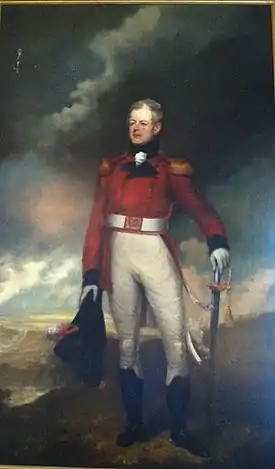
The war had been preceded by years of diplomatic dispute, yet neither side was ready for war when it came. Britain was heavily engaged in the Napoleonic Wars, most of the British Army was deployed in the Peninsular War in Portugal and Spain, and the Royal Navy was blockading most of the coast of Europe.[106] The number of British regular troops present in Canada in July 1812 was officially 6,034, supported by additional Canadian militia.[107] Throughout the war, the British Secretary of State for War and the Colonies was Earl Bathurst, who had few troops to spare for reinforcing North America defences during the first two years of the war. He urged Lieutenant General George Prévost to maintain a defensive strategy. Prévost followed these instructions and concentrated on defending Lower Canada at the expense of Upper Canada, which was more vulnerable to American attacks and allowed few offensive actions.
The United States was also not prepared for war. Madison had assumed that the state militias would easily seize Canada and that negotiations would follow. In 1812, the regular army consisted of fewer than 12,000 men. Congress authorized the expansion of the army to 35,000 men, but the service was voluntary and unpopular; it paid poorly and there were initially few trained and experienced officers.[108] The militia objected to serving outside their home states, they were undisciplined and performed poorly against British forces when outside their home states.[106] Multiple militia refused orders to cross the border and fight on Canadian soil.[109]
American prosecution of the war suffered from its unpopularity, especially in New England where anti-war speakers were vocal. Massachusetts Congressmen Ebenezer Seaver and William Widgery were "publicly insulted and hissed" in Boston while a mob seized Plymouth's Chief Justice Charles Turner on 3 August 1812 "and kicked [him] through the town".[110] The United States had great difficulty financing its war. It had disbanded its national bank, and private bankers in the Northeast were opposed to the war, but it obtained financing from London-based Barings Bank to cover overseas bond obligations.[7] New England failed to provide militia units or financial support, which was a serious blow,[111] and New England states made loud threats to secede as evidenced by the Hartford Convention. Britain exploited these divisions, blockading only southern ports for much of the war and encouraging smuggling.[112]
Invasions of Upper and Lower Canada, 1812

An American army commanded by William Hull invaded Upper Canada on July 12, arriving at Sandwich (Windsor, Ontario) after crossing the Detroit River.[113] His forces were chiefly composed of untrained and ill-disciplined militiamen.[114] Hull issued a proclamation ordering all British subjects to surrender, or "the horrors, and calamities of war will stalk before you".[115] The proclamation said that Hull wanted to free them from the "tyranny" of Great Britain, giving them the liberty, security, and wealth that his own country enjoyed—unless they preferred "war, slavery and destruction".[116] He also threatened to kill any British soldier caught fighting alongside indigenous fighters.[115] Hull's proclamation only helped to stiffen resistance to the American attacks as he lacked artillery and supplies. Hull also had to fight just to maintain his own lines of communication.[117][118]
Hull withdrew to the American side of the river on 7 August 1812 after receiving news of a Shawnee ambush on Major Thomas Van Horne's 200 men, who had been sent to support the American supply convoy. Half of Horne's troops had been killed. Hull had also faced a lack of support from his officers and fear among his troops of a possible massacre by unfriendly indigenous forces. A group of 600 troops led by Lieutenant Colonel James Miller remained in Canada, attempting to supply the American position in the Sandwich area, with little success.[119]
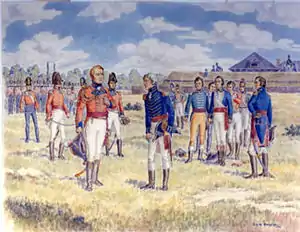
Major General Isaac Brock believed that he should take bold measures to calm the settler population in Canada and to convince the tribes that Britain was strong.[114] He moved to Amherstburg near the western end of Lake Erie with reinforcements and attacked Detroit, using Fort Malden as his stronghold. Hull feared that the British possessed superior numbers; also Fort Detroit lacked adequate gunpowder and cannonballs to withstand a long siege.[120] He agreed to surrender on 16 August, saving his 2,500 soldiers and 700 civilians from "the horrors of an Indian massacre", as he wrote.[121][122] Hull also ordered the evacuation of Fort Dearborn (Chicago) to Fort Wayne, but Potawatomi warriors attacked them on 15 August after they had traveled only 2 miles (3.2 km).[123] The fort was subsequently burned.
Brock moved to the eastern end of Lake Erie, where American General Stephen Van Rensselaer was attempting a second invasion.[124] The Americans attempted an attack across the Niagara River on 13 October, but they were defeated at Queenston Heights. Brock was killed during the battle and British leadership suffered after his death. American General Henry Dearborn made a final attempt to advance north from Lake Champlain, but his militia refused to go beyond American territory.
American Northwest, 1813
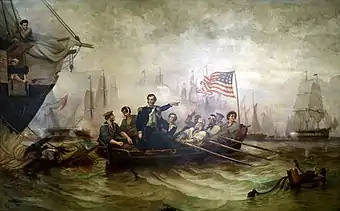
After Hull surrendered Detroit, General William Henry Harrison took command of the American Army of the Northwest. He set out to retake the city, which was now defended by Colonel Henry Procter and Tecumseh. A detachment of Harrison's army was defeated at Frenchtown along the River Raisin on 22 January 1813. Procter left the prisoners with an inadequate guard and his Potowatomie allies killed 60 captive Americans.[126] The defeat ended Harrison's campaign against Detroit, but "Remember the River Raisin!" became a rallying cry for the Americans.
In May 1813, Procter and Tecumseh set siege to Fort Meigs in northwestern Ohio. Tecumseh's fighters ambushed American reinforcements who arrived during the siege, but the fort held out. The fighters eventually began to disperse, forcing Procter and Tecumseh to return to Canada. Along the way they attempted to storm Fort Stephenson, a small American post on the Sandusky River near Lake Erie. They were repulsed with serious losses, marking the end of the Ohio campaign.
Captain Oliver Hazard Perry fought the Battle of Lake Erie on 10 September 1813. His decisive victory at Put-in-Bay ensured American military control of the lake, improved American morale after a series of defeats and compelled the British to fall back from Detroit. This enabled General Harrison to launch another invasion of Upper Canada, which culminated in the American victory at the Battle of the Thames on 5 October 1813. Tecumseh was killed at that battle.
Niagara frontier, 1813
British and American leaders placed great importance on gaining control of the Great Lakes and the St. Lawrence River because of the difficulties of land-based communication. The British already had a small squadron of warships on Lake Ontario when the war began and had the initial advantage. The Americans established a Navy yard at Sackett's Harbor, New York, a port on Lake Ontario. Commodore Isaac Chauncey took charge of the thousands of sailors and shipwrights assigned there and recruited more from New York. They completed a warship (the corvette USS Madison) in 45 days. Ultimately, almost 3,000 men at the shipyard built 11 warships and many smaller boats and transports. Army forces were also stationed at Sackett's Harbor, where they camped out through the town, far surpassing the small population of 900. Officers were housed with families. Madison Barracks was later built at Sackett's Harbor.
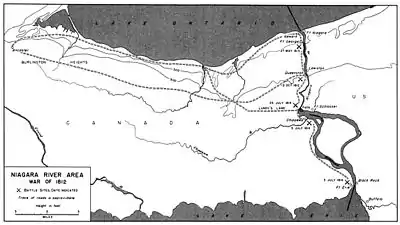
Having regained the advantage by their rapid building program, on 27 April 1813 Chauncey and Dearborn attacked York, the capital of Upper Canada. At the Battle of York, the outnumbered British regulars destroyed the fort and dockyard and retreated, leaving the militia to surrender the town. American soldiers set fire to the Legislature building, and looted and vandalised several government buildings and citizen's homes.
On 25 May 1813, Fort Niagara and the American Lake Ontario squadron began bombarding Fort George.[127] An American amphibious force assaulted Fort George on the northern end of the Niagara River on 27 May and captured it without serious losses.[128] The British abandoned Fort Erie and headed towards Burlington Heights.[128] The British position was close to collapsing in Upper Canada; the Iroquois considered changing sides and ignored a British appeal to come to their aid.[128] However, the Americans did not pursue the retreating British forces until they had largely escaped and organized a counter-offensive at the Battle of Stoney Creek on 5 June. The British launched a surprise attack at 2 a.m., leading to much confused fighting[128] and a strategic British victory.[129]
The Americans pulled back to Forty Mile Creek rather than continue their advance into Upper Canada.[128] At this point, the Six Nations of the Grand River began to come out to fight for the British as an American victory no longer seemed inevitable.[128] The Iroquois ambushed an American patrol at Forty Mile Creek while the Royal Navy squadron based in Kingston sailed in and bombarded the American camp. General Dearborn retreated to Fort George, mistakenly believing that he was outnumbered and outgunned.[130] British Brigadier General John Vincent was encouraged when about 800 Iroquois arrived to assist him.[130]
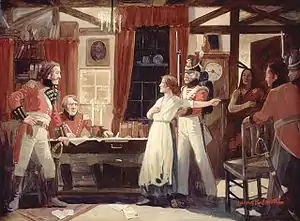
An American force surrendered on 24 June to a smaller British force due to advance warning by Laura Secord at the Battle of Beaver Dams, marking the end of the American offensive into Upper Canada.[130] British Major General Francis de Rottenburg did not have the strength to retake Fort George, so he instituted a blockade, hoping to starve the Americans into surrender.[131] Meanwhile, Commodore James Lucas Yeo had taken charge of the British ships on the lake and mounted a counterattack, which the Americans repulsed at the Battle of Sackett's Harbor. Thereafter, Chauncey and Yeo's squadrons fought two indecisive actions, off the Niagara on 7 August and at Burlington Bay on 28 September. Neither commander was prepared to take major risks to gain a complete victory.[132]
Late in 1813, the Americans abandoned the Canadian territory that they occupied around Fort George. They set fire to the village of Newark (now Niagara-on-the-Lake) on 10 December 1813, incensing the Canadians. Many of the inhabitants were left without shelter, freezing to death in the snow. The British retaliated following their Capture of Fort Niagara on 18 December 1813. The British and their Indian allies stormed the neighbouring town of Lewiston, New York on 19 December, torching homes and killing about a dozen civilians. The British were pursuing the surviving residents when a small force of Tuscarora warriors intervened, buying enough time for the civilians to escape to safer ground.[133][134] The British attacked and burned Buffalo on Lake Erie on 30 December 1813 in revenge for the Newark attack.
St. Lawrence and Lower Canada, 1813
The British were vulnerable along the stretch of the St. Lawrence that was between Upper Canada and the United States. In the winter of 1812–1813, the Americans launched a series of raids from Ogdensburg, New York that hampered British supply traffic up the river. On 21 February, George Prévost passed through Prescott, Ontario on the opposite bank of the river with reinforcements for Upper Canada. When he left the next day, the reinforcements and local militia attacked in the Battle of Ogdensburg and the Americans were forced to retreat.
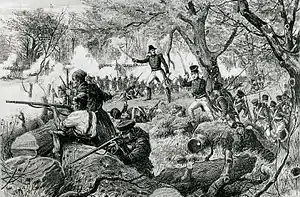
The Americans made two more thrusts against Montreal in 1813.[135] Major General Wade Hampton was to march north from Lake Champlain and join a force under General James Wilkinson that would sail from Sackett's Harbor on Lake Ontario and descend the St. Lawrence. Hampton was delayed by road and supply problems and his intense dislike of Wilkinson limited his desire to support his plan. Charles de Salaberry defeated Hampton's force of 4,000 at the Chateauguay River on 25 October with a smaller force of Canadian Voltigeurs and Mohawks. Salaberry's force numbered only 339, but it had a strong defensive position.[135] Wilkinson's force of 8,000 set out on 17 October, but it was delayed by weather. Wilkinson heard that a British force was pursuing him under Captain William Mulcaster and Lieutenant Colonel Joseph Wanton Morrison and landed near Morrisburg, Ontario by 10 November, about 150 kilometres (90 mi) from Montreal. On 11 November, his rear guard of 2,500 attacked Morrison's force of 800 at Crysler's Farm and was repulsed with heavy losses.[135] He learned that Hampton could not renew his advance, retreated to the United States and settled into winter quarters. He resigned his command after a failed attack on a British outpost at Lacolle Mills.
Niagara and Plattsburgh campaigns, 1814

The Americans again invaded the Niagara frontier. They had occupied southwestern Upper Canada after their victory at Moraviantown and believed that taking the rest of the province would force the British to cede it to them. The end of the war with Napoleon in Europe in April 1814 meant that the British could deploy their army to North America, so the Americans wanted to secure Upper Canada to negotiate from a position of strength. They planned to invade via the Niagara frontier while sending another force to recapture Mackinac.[137] Meanwhile, the British were supplying the Indians in the Old Northwest from Montreal via Mackinac.[138] They captured Fort Erie on 3 July 1814.[139] Unaware of Fort Erie's fall or of the size of the American force, the British general Phineas Riall engaged with Winfield Scott, who won against a British force at the Battle of Chippawa on 5 July. The Americans brought out overwhelming firepower against the attacking British, who lost about 600 dead to the 350 dead on the American side.
An attempt to advance further ended with the hard-fought but inconclusive Battle of Lundy's Lane on July 25. Both sides stood their ground as American General Jacob Brown pulled back to Fort George after the battle and the British did not pursue.[140]

The Americans withdrew but withstood a prolonged siege of Fort Erie. The British tried to storm Fort Erie on 14 August 1814, but they suffered heavy losses, losing 950 killed, wounded and captured compared to only 84 dead and wounded on the American side. The British were further weakened by exposure and shortage of supplies. Eventually, they raised the siege, but American Major General George Izard took over command on the Niagara front and followed up only halfheartedly. An American raid along the Grand River destroyed many farms and weakened British logistics. In October 1814, the Americans advanced into Upper Canada and engaged in skirmishes at Cook's Mill, but they pulled back when they heard that the new British warship HMS St Lawrence, launched in Kingston that September, was on its way, armed with 104 guns. The Americans lacked provisions and retreated across the Niagara after destroying Fort Erie.[141]
Meanwhile, 15,000 British troops were sent to North America under four of Wellington's ablest brigade commanders after Napoleon abdicated. Fewer than half were veterans of the Peninsula and the rest came from garrisons. Prévost was ordered to neutralize American power on the lakes by burning Sackets Harbor to gain naval control of Lake Erie, Lake Ontario and the Upper Lakes as well as to defend Lower Canada from attack. He did defend Lower Canada but otherwise failed to achieve his objectives,[142] so he decided to invade New York State. His army outnumbered the American defenders of Plattsburgh, but he was worried about his flanks and decided that he needed naval control of Lake Champlain. The British squadron on the lake under Captain George Downie was more evenly matched by the Americans under Master Commandant Thomas Macdonough.
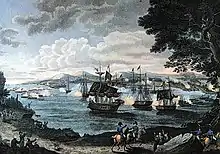
Upon reaching Plattsburgh, Prévost delayed the assault until Downie arrived in the hastily completed 36-gun frigate HMS Confiance. Prévost forced Downie into a premature attack but then unaccountably failed to provide the promised military backing. Downie was killed and his naval force defeated at the naval Battle of Plattsburgh in Plattsburgh Bay on 11 September 1814. The Americans now had control of Lake Champlain; Theodore Roosevelt later termed it "the greatest naval battle of the war". General Alexander Macomb led the successful land defence. Prévost then turned back, to the astonishment of his senior officers, saying that it was too hazardous to remain on enemy territory after the loss of naval supremacy. He was recalled to London where a naval court-martial decided that defeat had been caused principally by Prévost urging the squadron into premature action and then failing to afford the promised support from the land forces. He died suddenly, just before his court-martial was to convene. His reputation sank to a new low as Canadians claimed that their militia under Brock did the job but Prévost failed. However, recent historians have been kinder. Peter Burroughs argues that his preparations were energetic, well-conceived and comprehensive for defending the Canadas with limited means and that he achieved the primary objective of preventing an American conquest.[144]
American West, 1813–1815
The Mississippi River valley was the western frontier of the United States in 1812. The territory acquired in the Louisiana Purchase of 1803 contained almost no American settlements west of the Mississippi except around St. Louis and a few forts and trading posts in the Boonslick. Fort Belle Fontaine was an old trading post converted to an Army post in 1804 and this served as regional headquarters. Fort Osage, built in 1808 along the Missouri River, was the westernmost American outpost, but it was abandoned at the start of the war.[145] Fort Madison was built along the Mississippi in Iowa in 1808 and had been repeatedly attacked by British-allied Sauk since its construction. The United States Army abandoned Fort Madison in September 1813 after the indgenous fighters attacked it and besieged it—with support from the British. This was one of the few battles fought west of the Mississippi. Black Hawk played a leadership role.[146]
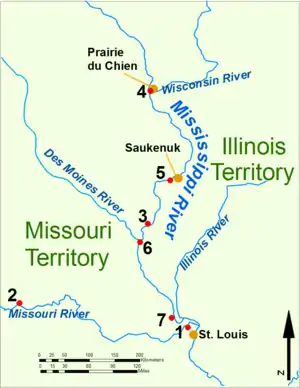
- Fort Belle Fontaine, American headquarters
- Fort Osage, abandoned in 1813
- Fort Madison, defeated in 1813
- Fort Shelby, defeated in 1814
- Battle of Rock Island Rapids, July 1814; and the Battle of Credit Island, September 1814
- Fort Johnson, abandoned in 1814
- Fort Cap au Gris and the Battle of the Sink Hole, May 1815
The American victory on Lake Erie and the recapture of Detroit isolated the British on Lake Huron. In the winter a Canadian party under Lieutenant Colonel Robert McDouall established a new supply line from York to Nottawasaga Bay on Georgian Bay. He arrived at Fort Mackinac with supplies and reinforcements, then sent an expedition to recapture the trading post of Prairie du Chien in the far west. The Siege of Prairie du Chien ended in a British victory on 20 July 1814.
Earlier in July, the Americans sent a force of five vessels from Detroit to recapture Mackinac. A mixed force of regulars and volunteers from the militia landed on the island on 4 August. They did not attempt to achieve surprise, and Indians ambushed them in the brief Battle of Mackinac Island and forced them to re-embark. The Americans discovered the new base at Nottawasaga Bay and destroyed its fortifications on 13 August along with the schooner Nancy that they found there. They then returned to Detroit, leaving two gunboats to blockade Mackinac. On 4 September, the gunboats were taken unawares and captured by British boarding parties from canoes and small boats. These engagements on Lake Huron left Mackinac under British control.
The British garrison at Prairie du Chien also fought off another attack by Major Zachary Taylor. American troops retreating from the Battle of Credit Island on the upper Mississippi attempted to make a stand at Fort Johnson, but soon abandoned the fort and most of the upper Mississippi valley.[147] In this distant theater, the British retained the upper hand until the end of the war through the allegiance of several Indigenous tribes, enabling them to take control of parts of Michigan and Illinois and all of Wisconsin.[148]
American forces were driven from the Upper Mississippi region, but they held onto eastern Missouri and the St. Louis area. Two notable battles fought against the Sauk were the Battle of Cote Sans Dessein in April 1815 at the mouth of the Osage River in the Missouri Territory and the Battle of the Sink Hole in May 1815 near Fort Cap au Gris.[149]
The British returned Mackinac and other captured territory to the United States after the war. Some British officers and Canadians objected to handing back Prairie du Chien and especially Mackinac under the terms of the Treaty of Ghent. However, the Americans retained the captured post at Fort Malden near Amherstburg until the British complied with the treaty.[150]
Fighting between Americans, the Sauk and other indigenous tribes continued through 1817, well after the war ended in the east.[151]
Opening strategies
In 1812, Britain's Royal Navy was the world's largest with over 600 cruisers in commission and some smaller vessels, and the world's most powerful Navy following the defeat of the French Navy at Trafalgar.[90] Most of these were blockading the French navy and protecting British trade against French privateers, but the Royal Navy still had 85 vessels in American waters, counting all North American and Caribbean waters.[lower-alpha 5] However, the Royal Navy's American squadron based in Halifax, Nova Scotia numbered one small ship of the line and seven frigates as well as nine smaller sloops and brigs and five schooners.[153] By contrast, the United States Navy was composed of 8 frigates, 14 smaller sloops and brigs, with no ships of the line. The United States had embarked on a major shipbuilding program before the war at Sackets Harbor, New York and continued to produce new ships. Three of the existing American frigates were exceptionally large and powerful for their class, larger than any British frigate in America. The standard British frigate of the time was rated as a 38 gun ship, usually carrying up to 50 guns, with its main battery consisting of 18-pounder. In comparison, USS Constitution, President and United States were rated as 44-gun ships, carrying 56–60 guns with a main battery of 24-pounders.[154]
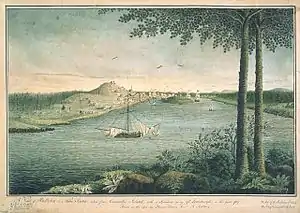
The British strategy was to protect their own merchant shipping between Halifax and the West Indies, with the order given on 13 October 1812 to enforce a blockade of major American ports to restrict American trade.[155] Because of their numerical inferiority, the American strategy was to cause disruption through hit-and-run tactics such as the capturing prizes and engaging Royal Navy vessels only under favourable circumstances. Days after the formal declaration of war, the United States put out two small squadrons, including the frigate President and the sloop Hornet under Commodore John Rodgers and the frigates United States and Congress, with the brig Argus under Captain Stephen Decatur. These were initially concentrated as one unit under Rodgers, who intended to force the Royal Navy to concentrate its own ships to prevent isolated units being captured by his powerful force.
Large numbers of American merchant ships were returning to the United States with the outbreak of war and the Royal Navy could not watch all the ports on the American seaboard if they were concentrated together. Rodgers' strategy worked in that the Royal Navy concentrated most of its frigates off New York Harbor under Captain Philip Broke, allowing many American ships to reach home. However, Rodgers' own cruise captured only five small merchant ships, and the Americans never subsequently concentrated more than two or three ships together as a unit.[156]
Single-ship actions
Both Americans and British felt their navies' honour had been challenged prior to the war. The United States took the Chesapeake–Leopard affair and the Royal Navy's impressment of sailors as an insult and felt it could redeem itself by duelling. Similarly, the British felt their honour was challenged in the Little Belt affair where the United States frigate President fired on the British sloop HMS Little Belt, mistaking it for the British frigate HMS Guerriere. Captain James Dacres of Guerriere began a cycle of frigate duels by challenging President to a single ship duel to avenge the losses aboard Little Belt. Commodore John Rodgers of President declined the challenge because he feared that the rest of the British squadron under Commodore Philip Broke might intervene.[33][157][158]
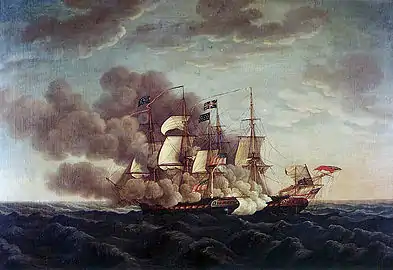
Meanwhile, USS Constitution commanded by Captain Isaac Hull sailed from the Chesapeake Bay on 12 July 1812. On 17 July, Commodore Broke's British squadron, including Guerriere, gave chase off New York, but Constitution evaded them after two days. Broke detached Guerriere from his squadron to seek out repairs as she had weak scantlings (Beams fastened with a thickened clamp rather than vertical and horizontal knees)[159] and had become leaky and rotten.[33][158] She had also been struck by lightning, severely damaging her masts.[33] Captain Dacres was eager to engage the American frigate and to redeem British honour as Constitution was the sister ship of President and would serve equally well as an American ship to duel. Constitution had nearly 50 percent more men, more firepower, heavier tonnage and heavier scantlings (this determines how much damage enemy shot does to a ship) than Guerriere.
Constitution sighted Guerriere 400 miles off the coast of Nova Scotia on August 19, and the two ships engaged in a 35-minute battle. Constitution dismasted Guerriere and captured the crew. Guerriere was beyond repair and the Americans burned it before returning to Boston. Constitution earned the nickname "Old Ironsides" following this battle as many of the British cannonballs were seen to bounce off her hull due to her heavy scantlings.
On 25 October, the USS United States commanded by Captain Decatur captured the British frigate HMS Macedonian, which he then carried back to port.[160] At the close of the month, Constitution sailed south, now commanded by Captain William Bainbridge. She met the British frigate HMS Java on 29 December off Bahia, Brazil.[124] After a battle lasting three hours, Java struck her colours and was burned after being judged unsalvageable. Constitution seemed relatively undamaged initially, but the crew later determined that Java had successfully hit her masts with 18-pounder shot, but the mast had not fallen due to its diameter. United States, Constitution and President were all nearly 50 percent larger by tonnage, crew, firepower and scantling size than Macedonian, Guerriere and Java.[33][158][161] Guerriere was rotten and had lightning damage as well as being weakly built as a French ship while Java had extra marines onboard making the disparity in crew more similar although she too was a French-built ship; Macedonian fitted the 50 percent statistic near perfectly.[33][158][161]
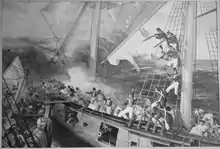
The United States Navy's sloops had also won several victories over Royal Navy sloops of approximately equal armament. The American sloops Hornet, Wasp (1807), Peacock, Wasp (1813) and Frolic were all ship-rigged while the British Cruizer-class sloops that they encountered were brig-rigged, which gave the Americans a significant advantage. Ship rigged vessels are more maneuverable in battle because they have a wider variety of sails and thus being more resistant to damage. Ship-rigged vessels can back sail, literally backing up or heave to (stop).[33][158][159] More significantly, if some spars are shot away on a brig because it is more difficult to wear and the brig loses the ability to steer while a ship could adjust its more diverse canvas to compensate for the imbalance caused by damage in battle.[33] Furthermore, ship-rigged vessels with three masts simply have more masts to shoot away than brigs with two masts before the vessel is unmanageable.[33][158] In addition, while the American ships had experienced and well-drilled volunteer crews, the enormous size of the overstretched Royal Navy meant that many ships were shorthanded and the average quality of crews suffered and the constant sea duties of those serving in North America interfered with their training and exercises.[33][157][158][161] The only engagement between two brig-sloops was between the British Cruizer-class brig Pelican (1812) and the United States' Argus where Pelican emerged the victor as she had greater firepower and tonnage, despite having fewer crew.[33] Although not a sloop, the gun-brig Boxer was taken by the brig-sloop Enterprise in a bloody battle where Enterprise emerged the victor again due to superior force.
In single ship battles, superior force was the most significant factor. In response to the majority of the American ships being of greater force than the British ships of the same class, Britain constructed five 40-gun, 24-pounder heavy frigates[162] and two "spar-decked" frigates (the 60-gun HMS Leander and HMS Newcastle)[163] and to razee three old 74-gun ships of the line to convert them to heavy frigates.[164] To counter the American sloops of war, the British constructed the Cyrus-class ship-sloop of 22 guns. The British Admiralty also instituted a new policy that the three American heavy frigates should not be engaged except by a ship of the line or frigates in squadron strength.
.jpg.webp)
Commodore Philip Broke had lost Guerriere to Constitution from his very own squadron. He knew that Dacres of Guerriere intended to duel the American frigate to avenge the losses on Little Belt caused by USS President in 1811. Since Constitution had taken Guerriere, Broke intended to redeem Dacres' honour by taking Constitution, which was undergoing repairs in Boston in early 1813. Broke found that Constitution was not ready for sea. Instead, he decided to challenge Chesapeake as Broke was short on water and provisions and could not wait for Constitution.[33] Captain James Lawrence of Chesapeake was misguided by propaganda intended to boost American morale (and successfully did) that claimed that the three frigate duels of 1812 were of equal force leading Lawrence to believe taking Broke's Shannon (1806) would be easy.[33][158] Lawrence even went to the extent of preemptively arranging for a banquet to be held for his victorious crew.[33][157][158][161] On the other hand, Broke had spent years training his crew and developing artillery innovations on his ship, making Shannon particularly well prepared for battle.[33][157][158][161] On 1 June 1813, Shannon took Chesapeake in a battle that lasted less than fifteen minutes in Boston Harbor. Lawrence was mortally wounded and famously cried out "Tell the men to fire faster! Don't give up the ship!"[33][157][158][161] The two frigates were of near-identical armament and length. Chesapeake's crew was larger, had greater tonnage and was of greater scantling strength (which led to the British claiming she was overbuilt,[165] but many of her crew had not served or trained together. Shannon had been at sea for a long time, and her hull had begun to rot, further exaggerating the disparity in scantling strength.[33] Nevertheless, this engagement proved to the only single-ship action where both ships were of essentially equal force during the War of 1812. British citizens reacted with celebration and relief that the run of American victories had ended.[166] Notably, this action was by ratio one of the bloodiest contests recorded during this age of sail due to the close-range engagement, the boarding (hand-to-hand combat) and Broke's philosophy of artillery being "Kill the men and the ship is yours", with more dead and wounded than HMS Victory suffered in four hours of combat at Trafalgar. Captain Lawrence was killed, and Captain Broke was so badly wounded that he never again held a sea command.[167] The Americans then did as the British had done in 1812 and banned single-ship duels after this engagement.[33][161]

In January 1813, the American frigate Essex, commanded by Captain David Porter, sailed into the Pacific to harass British shipping. Many British whaling ships carried letters of marque allowing them to prey on American whalers, and they nearly destroyed the industry. Essex challenged this practice. She inflicted considerable damage on British interests. Essex consort USS Essex Junior (armed with twenty guns) was captured off Valparaíso, Chile by the British frigate HMS Phoebe and the sloop HMS Cherub on 28 March 1814 in what statistically appeared to be a battle of equal force as Essex and Phoebe were of similar tonnage, scantling and broadside weight as well as Cherub and Essex Junior (with the exception of scantling, which Essex Junior was much more lightly built than Cherub).[33] Once again the Americans had more men. Nevertheless, Phoebe was armed with long guns that none of the other ships engaged had. This gave the British ships a significant advantage at the range at which the battle was fought. Once again proving that superior force was the deciding factor.[168]
To conclude the cycle of duels caused by the Little Belt affair, USS President was finally captured in January 1815. Unlike the previous engagements, President was not taken in a duel. Following the both Royal Navy's requirements, President was pursued by a squadron consisting of four frigates, one being a 56-gun razee. President was an extremely fast ship and successfully outsailed the fast British squadron with the exception of HMS Endymion, which has been regarded as the fastest ship in the age of fighting sail.[169] Captain Henry Hope of Endymion had fitted his ship with Phillip Broke's technology. This gave him the slight advantage at range and slowed President. Commodore Decatur on President had the advantage in scantling strength, firepower crew, and tonnage, but not in maneuverability. Despite having fewer guns, Endymion was armed with 24-pounders just like President. This meant that Endymion's shot could pierce the hull of President, unlike that of Guerriere, which bounced off Constitution's hull, or that of Java, which failed to cut through Constitution's mast. Following Broke's philosophy of "Kill the man and the ship is yours", Endymion fired into President's hull severely damaging her (shot holes below the waterline, 10/15 starboard guns on the gundeck disabled, water in the hold and shot from Endymion found inside President's magazine.[33] Decatur knew his only hope was to dismantle Endymion and sail away from the rest of the squadron. When he failed, he surrendered his ship to "the captain of the black frigate (Endymion)". Decatur took advantage of the fact Endymion had no boats that were intact and attempted to sneak away under the cover of night, only to be caught up by HMS Pomone. Decatur surrendered without a fight.[33][158] Decatur had surrendered the United States finest frigate and flagship President to a smaller ship, but part of a squadron of greater force.
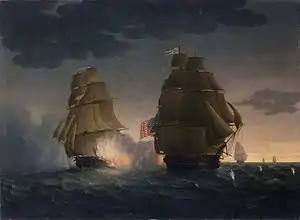
Decatur gave unreliable accounts of the battle stating that President was already "severely damaged" by a grounding before the engagement, but undamaged after the engagement with Endymion. He stated Pomone caused "significant" losses aboard President, although President's crew claim they were below deck gathering their belongings as they had already surrendered. Despite saying "I surrender my ship to the captain of the black frigate", Decatur also writes that he said, "I surrender to the squadron". Nevertheless, many historians such as Ian Toll, Theodore Roosevelt and William James quote Decatur's remarks to either enforce that Endymion alone took President or that President surrendered to the whole squadron, when actually it was something in-between.[33][157][158][161]
Success in single ship battles raised American morale after the repeated failed invasion attempts in Upper and Lower Canada. However, these victories had no military effect on the war at sea as they did not alter the balance of naval power, impede British supplies and reinforcements, or even raise insurance rates for British trade.[170] During the war, the United States Navy captured 165 British merchantmen (although privateers captured many more) while the Royal Navy captured 1,400 American merchantmen.[171] More significantly, the British blockade of the Atlantic coast caused the majority of warships to be unable to put to sea and shut down both American imports and exports.
Privateering
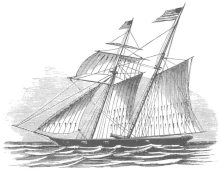
The operations of American privateers proved a more significant threat to British trade than the United States Navy. They operated throughout the Atlantic until the close of the war, most notably from Baltimore. American privateers reported taking 1300 British merchant vessels, compared to 254 taken by the United States Navy,[172][173][174] although the insurer Lloyd's of London reported that only 1,175 British ships were taken, 373 of which were recaptured, for a total loss of 802.[175] The Canadian historian Carl Benn wrote that American privateers took 1,344 British qships, of which 750 were retaken by the British.[171] However, the British limited privateering losses by the strict enforcement of convoy by the Royal Navy[176] and by capturing 278 American privateers. Due to the massive size of the British merchant fleet, American captures only affected 7.5% of the fleet, resulting in no supply shortages or lack of reinforcements for British forces in North America.[177] Of 526 American privateers, 148 were captured by the Royal Navy and only 207 ever took a prize.[171]
Due to the large size of their navy, the British did not rely as much on privateering. The majority of the 1,407 captured American merchant ships were taken by the Royal Navy. The war was the last time the British allowed privateering, since the practice was coming to be seen as politically inexpedient and of diminishing value in maintaining its naval supremacy. However, privateering remained popular in British colonies. It was the last hurrah for privateers in Bermuda who vigorously returned to the practice with experience gained in previous wars.[178] The nimble Bermuda sloops captured 298 American ships. Privateer schooners based in British North America, especially from Nova Scotia took 250 American ships and proved especially effective in crippling American coastal trade and capturing American ships closer to shore than the Royal Navy cruisers.[179]
Blockade

The naval blockade of the United States began informally in 1812 and was in effect by November of that year.[155] It expanded to cut off more ports as the war progressed.[171] Twenty ships were on station in 1812 and 135 were in place by the end of the conflict.[171] In March 1813, the Royal Navy punished the Southern states, who were most vocal about annexing British North America, by blockading Charleston, Port Royal, Savannah and New York City as well.[171] Additional ships were sent to North America in 1813 and the Royal Navy tightened and extended the blockade, first to the coast south of Narragansett by November 1813 and to the entire American coast on 31 May 1814.[171] In May 1814, following the abdication of Napoleon and the end of the supply problems with Wellington's army, New England was blockaded.[180]
The British needed American foodstuffs for their army in Spain and benefited from trade with New England, so they did not at first blockade New England.[171] The Delaware River and Chesapeake Bay were declared in a state of blockade on 26 December 1812. Illicit trade was carried on by collusive captures arranged between American traders and British officers. American ships were fraudulently transferred to neutral flags. Eventually, the United States government was driven to issue orders to stop illicit trading. This put only a further strain on the commerce of the country. The British fleet occupied the Chesapeake Bay and attacked and destroyed numerous docks and harbours.[181] The effect was that no foreign goods could enter the United States on ships and only smaller fast boats could attempt to get out. The cost of shipping became very expensive as a result.[17]
The blockade of American ports later tightened to the extent that most American merchant ships and naval vessels were confined to port. The American frigates USS United States and USS Macedonian ended the war blockaded and hulked in New London, Connecticut.[182] USS United States and USS Macedonian attempted to set sail to raid British shipping in the Caribbean, but were forced to turn back when confronted with a British squadron, and by the end of the war, the United States had six frigates and four ships-of-the-line sitting in port.[183] Some merchant ships were based in Europe or Asia and continued operations. Others, mainly from New England, were issued licences to trade by Admiral Sir John Borlase Warren, commander in chief on the American station in 1813. This allowed Wellington's army in Spain to receive American goods and to maintain the New Englanders' opposition to the war. The blockade nevertheless decreased American exports from $130 million in 1807 to $7 million in 1814. Most exports were goods that ironically went to supply their enemies in Britain or the British colonies.[184] The blockade had a devastating effect on the American economy with the value of American exports and imports falling from $114 million in 1811 down to $20 million by 1814 while the United States Customs took in $13 million in 1811 and $6 million in 1814, even though the Congress had voted to double the rates.[20] The British blockade further damaged the American economy by forcing merchants to abandon the cheap and fast coastal trade to the slow and more expensive inland roads.[185] In 1814, only 1 out of 14 American merchantmen risked leaving port as it was likely that any ship leaving port would be seized.[185][186]
As the Royal Navy base that supervised the blockade, Halifax profited greatly during the war. From there, British privateers seized and sold many French and American ships. More than a hundred prize vessels were anchored in St. George's Harbour awaiting condemnation by the Admiralty Court when a hurricane struck in 1815, sinking roughly sixty of the vessels.[187]
Freeing and recruiting slaves
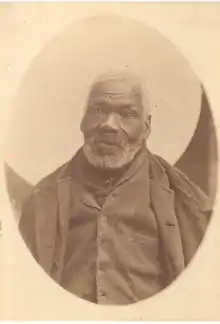
The British Royal Navy's blockades and raids allowed about 4,000 African Americans to escape slavery by fleeing American plantations aboard British ships. American slaves near to the British military rebelled against their masters and made their way to British encampments. The migrants who settled in Canada were known as the Black Refugees. The blockading British fleet in the Chesapeake Bay received increasing numbers of freed slaves during 1813. By British government order, they were considered free persons when they reached British hands.[8][189] Alexander Cochrane's proclamation of 2 April 1814 invited Americans who wished to emigrate to join the British. Although it did not explicitly mention slaves, it was taken by all as addressed to them. About 2,400 escaped slaves and their families were carried by the Royal Navy to the Royal Naval Dockyard at Bermuda (where they were employed on works about the yard and organised as a militia to aid in the defence of the yard), Nova Scotia and New Brunswick during and after the war. Starting in May 1814, younger male volunteers were recruited into a new Corps of Colonial Marines. They fought for Britain throughout the Atlantic campaign, including the Battle of Bladensburg and the attacks on Washington, D.C. and Battle of Baltimore, before withdrawing to Bermuda with the rest of the British forces. They were later settled in Trinidad after having rejected orders for transfer to the West India Regiments, forming the community of the Merikins (none of the freed slaves remained in Bermuda after the war). These escaped slaves represented the largest emancipation of African Americans prior to the American Civil War.[190][191][192] Britain paid the United States for the financial loss of the slaves at the end of the war.
Occupation of Maine
Maine, then part of Massachusetts, was a base for smuggling and illegal trade between the United States and the British. Until 1813, the region was generally quiet except for privateer actions near the coast. In September 1813, the United States Navy's brig Enterprise fought and captured the Royal Navy brig Boxer off Pemaquid Point.[193]
On 11 July 1814, Thomas Masterman Hardy took Moose Island (Eastport, Maine) without a shot and the entire American garrison, 65 men[194] of Fort Sullivan peacefully surrendered.[195] The British temporarily renamed the captured fort "Fort Sherbrooke". In September 1814, John Coape Sherbrooke led 3,000 British troops from his base in Halifax, Nova Scotia in the "Penobscot Expedition". In 26 days, he raided and looted Hampden, Bangor and Machias, destroying or capturing 17 American ships. He won the Battle of Hampden, with two killed while the Americans had one killed. Retreating American forces were forced to destroy the frigate Adams.
The British occupied the town of Castine and most of eastern Maine for the rest of the war, governing it under martial law[196] and re-establishing the colony of New Ireland. The Treaty of Ghent returned this territory to the United States. When the British left in April 1815, they took £10,750 in tariff duties from Castine. This money, called the "Castine Fund", was used to establish Dalhousie University in Halifax.[197] Decisions about the islands in Passamaquoddy Bay were decided by joint commission in 1817.[23] However, Machias Seal Island had been seized by the British as part of the occupation and was unaddressed by the commission. While kept by Britain/Canada, it remains in dispute to this day.[198][199]
Chesapeake campaign
The strategic location of the Chesapeake Bay near the Potomac River made it a prime target for the British. Starting in March 1813, a squadron under Rear Admiral George Cockburn started a blockade of the mouth of the Bay at Hampton Roads harbour and raided towns along the Bay from Norfolk, Virginia to Havre de Grace, Maryland. On 4 July 1813, Commodore Joshua Barney, a Revolutionary War naval hero, convinced the Navy Department to build the Chesapeake Bay Flotilla, a squadron of twenty barges powered by small sails or oars (sweeps) to defend the Chesapeake Bay. Launched in April 1814, the squadron was quickly cornered on the Patuxent River. While successful in harassing the Royal Navy, they could not stop subsequent British operations in the area.
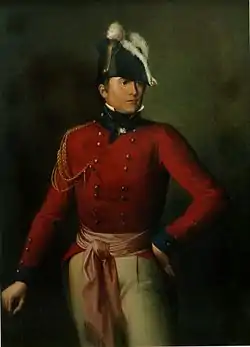
In August 1814, a force of 2,500 soldiers under General Ross had just arrived in Bermuda aboard HMS Royal Oak, three frigates, three sloops and ten other vessels. Released from the Peninsular War by victory, the British intended to use them for diversionary raids along the coasts of Maryland and Virginia. In response to Prévost's request, they decided to employ this force, together with the naval and military units already on the station, to strike at the national capital.
United States Secretary of War John Armstrong Jr. insisted that the British were going to attack Baltimore rather than Washington, even as British army and naval units were on their way to Washington. Brigadier General William H. Winder assumed the British would attack Annapolis and was reluctant to engage because he mistakenly thought the British army was twice its size.[200] The inexperienced state militia was easily routed in the Battle of Bladensburg, opening the route to Washington.
Capture of Washington
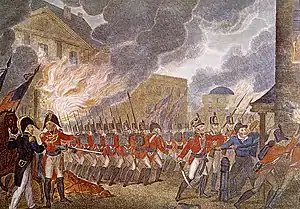
In August 1814, British troops led by Major General Robert Ross, accompanied by Rear Admiral George Cockburn, attacked and captured Washington with a force of 4,500. On 24 August, Ross directed his troops to set fire to number of public buildings, including the White House and the United States Capitol. Extensive damage to the interiors and the contents of both were subsequently reported. [201][202]
The plan to attack Washington had been formulated by Rear Admiral Cockburn, who accurately predicted that "within a short period of time, with enough force, we could easily have at our mercy the capital".[203] Major General Ross was less optimistic. He "never dreamt for one minute that an army of 3,500 men with 1,000 marines reinforcement, with no cavalry, hardly any artillery, could march 50 miles inland and capture an enemy capital", according to CBC News.[204] Ross also refused to accept Cockburn's recommendation to burn the entire city. He spared nearly all of the privately-owned properties.[202][205]
Many sources have suggested that the attack on Washington was motivated by revenge for the attack on York,[206] the present Toronto, Ontario, on the shore of Lake Ontario, during the Battle of York in April 1813. Research completed by the Washington Post, however, rebuts that claim: "The earlier arson of parliament buildings in York was not raised as a justification until months later, after the British faced criticism at home and abroad for burning buildings in Washington". Previously, the British had filed complaints only about the "wanton destruction" by Americans along the Niagara region and Lake Erie.[207]
While First Lady Dolley Madison saved valuables from the White House, senior officials fled to Virginia.[208] Secretary of the United States Navy William Jones ordered setting fire to the Washington Navy Yard to prevent the capture of supplies[209] and destroyed a nearby fort.[210] The nation's public buildings were destroyed by the British though private residences ordered spared.[211]
Battle of Baltimore and "The Star-Spangled Banner"
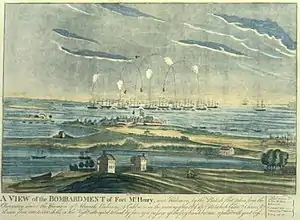
After taking some munitions from the Washington Munitions depot, the British, boarded their ships[210] and moved on to their major target, the heavily fortified major city of Baltimore. Because some of their ships were held up in the Raid on Alexandria, they delayed their movement allowing Baltimore an opportunity to strengthen the fortifications and bring in new federal troops and state militia units. The "Battle for Baltimore" began with the British landing on 12 September 1814 at North Point, where they were met by American militia further up the Patapsco Neck peninsula. An exchange of fire began, with casualties on both sides. The British Army commander Major Gen. Robert Ross was killed by snipers. The British paused, then continued to march northwestward to face the stationed Maryland and Baltimore City militia units at Godly Wood. The Battle of North Point was fought for several afternoon hours in a musketry and artillery duel. The British also planned to simultaneously attack Baltimore by water on the following day, 13 September, to support their military facing the massed, heavily dug-in and fortified American units of approximately 15,000 with about a hundred cannon gathered along the eastern heights of the city named Loudenschlager's Hill (later Hampstead Hill, now part of Patterson Park). The Baltimore defences had been planned in advance and overseen by the state militia commander, Major General Samuel Smith. The Royal Navy was unable to reduce Fort McHenry at the entrance to Baltimore Harbor in support of an attack from the northeast by the British Army.
The British naval guns, mortars and new "Congreve rockets" had a longer range than the American cannon onshore. The ships mostly stood out of range of the Americans, who returned very little fire. The fort was not heavily damaged except for a burst over a rear brick wall knocking out some field pieces but with few casualties. The British eventually realized that they could not force the passage to attack Baltimore in coordination with the land force. A last ditch night feint and barge attack during a heavy rain storm was led by Captain Charles Napier around the fort up the Middle Branch of the river to the west. Split and misdirected partly in the storm, it turned back after suffering heavy casualties from the alert gunners of Fort Covington and Battery Babcock. The British called off the attack and sailed downriver to pick up their army, which had retreated from the east side of Baltimore. All the lights were extinguished in Baltimore the night of the attack, and the fort was bombarded for 25 hours. The only light was given off by the exploding shells over Fort McHenry, illuminating the flag that was still flying over the fort. The defence of the fort inspired the American lawyer Francis Scott Key to write "Defence of Fort M'Henry", a poem that was later set to music as "The Star-Spangled Banner".[212]
Southern theater
Because of the region's polyglot population, both the British and the Americans perceived the war in the Gulf South as a fundamentally different conflict from the one occurring in the Lowcountry and Chesapeake.[213]:31
Creek War
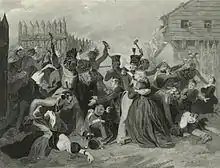
Before 1813, the war between the Creeks, or Muscogee, had been largely an internal affair sparked by the ideas of Tecumseh farther north in the Mississippi Valley. A faction known as the Red Sticks, so named for the colour of their war sticks, had broken away from the rest of the Creek Confederacy, which wanted peace with the United States. The Red Sticks were allied with Tecumseh, who had visited the Creeks about a year before 1813 and encouraged greater resistance to the Americans.[214] The Creek Nation was a trading partner of the United States, actively involved with British and Spanish trade as well. The Red Sticks as well as many southern Muscogee people like the Seminole had a long history of alliance with the British and Spanish empires.[215] This alliance helped the North American and European powers protect each other's claims to territory in the south.[216]
The Battle of Burnt Corn, between Red Sticks and United States troops, occurred in southern Alabama on 27 July 1813. It prompted the state of Georgia and the Mississippi militia to immediately take major action against Creek offensives. The Red Sticks chiefs gained power in the east along the Alabama River, Coosa River and Tallapoosa River in the Upper Creek territory. The Lower Creek lived along the Chattahoochee River. Many Creeks tried to remain friendly to the United States and some were organized by Indian agent Benjamin Hawkins to aid the 6th Military District under General Thomas Pinckney and the state militias. The United States combined forces were 5,000 troops from East and West Tennessesee, with about 200 indigenous allies.[217] At its peak, the Red Stick faction had 4,000 warriors, only a quarter of whom had muskets.[218]
On 30 August 1813, Red Sticks led by chiefs Red Eagle and Peter McQueen attacked Fort Mims north of Mobile, the only American-held port in the territory of West Florida. The attack on Fort Mims resulted in the death of 400 settlers and became an ideological rallying point for the Americans.[219]
The Indian frontier of western Georgia was the most vulnerable but was partially fortified already. From November 1813 to January 1814, Georgia's militia and auxiliary Federal troops from the Creek and Cherokee indigenous nations and the states of North Carolina and South Carolina organized the fortification of defences along the Chattahoochee River and expeditions into Upper Creek territory in present-day Alabama. The army, led by General John Floyd, went to the heart of the Creek Holy Grounds and won a major offensive against one of the largest Creek towns at the Battle of Autossee, killing an estimated two hundred people. In November, the militia of Mississippi with a combined 1,200 troops attacked the Econachca encampment in the Battle of Holy Ground on the Alabama River.[220] Tennessee raised a militia of 5,000 under Major General Andrew Jackson and Brigadier General John Coffee and won the battles of Tallushatchee and Talladega in November 1813.[221]
Jackson suffered enlistment problems in the winter. He decided to combine his force with that of the Georgia militia. From 22 to 24 January 1814, while on their way, the Tennessee militia and allied Muscogee were attacked by the Red Sticks at the Battles of Emuckfaw and Enotachopo Creek. Jackson's troops repelled the attackers, but they were outnumbered and forced to withdraw to his base at Fort Strother.[222]
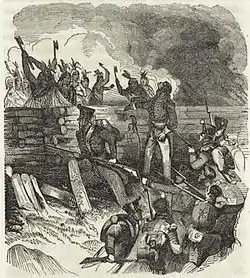
In January, Floyd's force of 1,300 state militia and 400 Creek Indians moved to join the United States forces in Tennessee, but they were attacked in camp on the Calibee Creek by Tukabatchee Muscogees on 27 January.
Jackson's force increased in numbers with the arrival of United States Army soldiers and a second draft of Tennessee state militia and Cherokee and Creek allies swelled his army to around 5,000. In March 1814, they moved south to attack the Creek.[223] On 27 March, Jackson decisively defeated the Creek force at Horseshoe Bend, killing 800 of 1,000 Creeks at a cost of 49 killed and 154 wounded out of approximately 2,000 American and Cherokee forces.[224] The American army moved to Fort Jackson on the Alabama River. On 9 August 1814, the Upper Creek chiefs and Jackson's army signed the Treaty of Fort Jackson. Most of western Georgia and part of Alabama was taken from the Creeks to pay for expenses borne by the United States. The treaty also demanded that the Red Stick insurgents cease communicating with the British and Spanish and trade only with United States-approved agents.[225]
British aid to the Red Sticks arrived after the end of the Napoleonic Wars in April 1814 and after Admiral Alexander Cochrane assumed command from Admiral Warren in March. The Creek promised to join any body of "troops that should aid them in regaining their lands, and suggesting an attack on the tower off Mobile". In April 1814, the British established an outpost on the Apalachicola River (Prospect Bluff Historic Sites). Cochrane sent a company of Royal Marines, the vessels HMS Hermes and HMS Carron commanded by Edward Nicolls and further supplies to meet the Native Americans.[226] In addition to training them, Nicolls was tasked to raise a force from escaped slaves as part of the Corps of Colonial Marines.[227]
In July 1814, General Jackson complained to the Governor of Pensacola, Mateo González Manrique that combatants from the Creek War were being harboured in Spanish territory and made reference to the British presence on Spanish soil. Although he gave an angry reply to Jackson, Manrique was alarmed at the weak position he found himself in and appealed to the British for help. Woodbine arrived on 28 July and Nicolls on 24 August.[228]
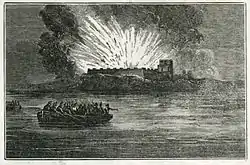
The first engagement of the British and their Creek allies against the Americans on the Gulf Coast was the 14 September 1814 attack on Fort Bowyer. Captain William Percy tried to take the United States fort, hoping to then move on Mobile and block United States trade and encroachment on the Mississippi. After the Americans repulsed Percy's forces, the British established a military presence of up to 200 Marines at Pensacola. In November, Jackson's force of 4,000 men took the town.[229] This underlined the superiority of numbers of Jackson's force in the region.[230] The United States force moved to New Orleans in late 1814. Jackson's army of 1,000 regulars and 3,000 to 4,000 militia, pirates and other fighters as well as civilians and slaves built fortifications south of the city.[231]
Gulf Coast
American forces under General James Wilkinson, himself a paid Spanish secret agent,[232] took the Mobile area—formerly part of West Florida—from the Spanish in March 1813. This was the only territory permanently gained by the United States during the war.[233] The Americans built Fort Bowyer, a log and earthen-work fort with 14 guns, on Mobile Point.[234]
At the end of 1814, the British launched a double offensive in the South weeks before the Treaty of Ghent was signed. On the Atlantic coast, Admiral George Cockburn was to close the Intracoastal Waterway trade and land Royal Marine battalions to advance through Georgia to the western territories. On the Gulf coast, Admiral Alexander Cochrane moved on the new state of Louisiana and the Mississippi Territory. Admiral Cochrane's ships reached the Louisiana coast on 9 December and Cockburn arrived in Georgia on 14 December.[235]
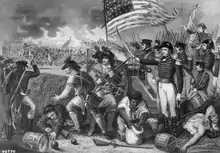
On 8 January 1815, a British force of 8,000 under General Edward Pakenham attacked Jackson's defences in New Orleans. The Battle of New Orleans was an American victory, as the British failed to take the fortifications on the East Bank. The British suffered high casualties, including 291 dead, 1,262 wounded and 484 captured or missing[236][237] whereas American casualties were 13 dead, 39 wounded and 19 missing. It was hailed as a great victory across the United States, making Jackson a national hero and eventually propelling him to the presidency.[238][239] The American garrison at Fort St. Philip endured ten days of bombardment from Royal Navy guns, which was a final attempt to invade Louisiana. British ships sailed away from the Mississippi River on 18 January. However, it was not until 27 January 1815 that the army rejoined the fleet, allowing for its departure.[240]
After New Orleans, the British moved to take Mobile a second time.[241] In preparation, General John Lambert laid siege to nearby Fort Bowyer for five days and took it, winning the Second Battle of Fort Bowyer on 12 February 1815. HMS Brazen brought news of the Treaty of Ghent the next day and the British abandoned the Gulf Coast.[242]
In January 1815, Admiral Cockburn succeeded in blockading the southeastern coast by occupying Camden County, Georgia. The British quickly took Cumberland Island, Fort Point Peter and Fort St. Tammany in a decisive victory. Under the orders of his commanding officers, Cockburn's forces relocated many refugee slaves, capturing St. Simons Island as well to do so. During the invasion of the Georgia coast, an estimated 1,485 people chose to relocate in British territories or join the military. In mid-March, several days after being informed of the Treaty of Ghent, British ships finally left the area.[243]
Treaty of Ghent
Factors leading to the peace negotiations
By 1814, both Britain and the United States either achieved their main war goals or were weary of the costly stalemate. They both sent delegations to Ghent, a neutral site. The negotiations began in early August and concluded on December 24, when a final agreement was signed as both sides had to ratify it before it could take effect. Meanwhile, both sides planned new invasions.

In 1814, the British began blockading the United States and brought the federal treasury to long delays in paying its bills,[244] forcing it to rely on loans for the rest of the war. American foreign trade was reduced to a trickle. The parlous American economy was thrown into chaos, with prices soaring and unexpected shortages causing hardship in New England, which was considering secession.[245][246] The Hartford Convention led to widespread fears that the New England states might attempt to leave the Union, which was exaggerated as most New Englanders did not wish to leave the Union and merely wanted an end to a war that was bringing much economic hardship, suggested that the continuation of the war might threaten the union,[247] but also to a lesser extent British interests were hurt in the West Indies and Canada that had depended on that trade. Although American privateers found chances of success much reduced, with most British merchantmen now sailing in convoy, privateering continued to prove troublesome to the British, as shown by high insurance rates.[248] British landowners grew weary of high taxes and colonial interests and merchants called on the government to reopen trade with the United States by ending the war.[249]
Negotiations and peace
In August 1814, peace discussions began. Both sides approached negotiations warily.[lower-alpha 6] British diplomats stated their case first, demanding the creation of a Native American barrier state in the American Northwest Territory (the area from Ohio to Wisconsin). It was understood the British would sponsor this state. The British strategy for decades had been to create a buffer state to block American expansion. Britain also demanded naval control of the Great Lakes and access to the Mississippi River. The Americans refused to consider a buffer state and the proposal was dropped.[250] Although Article IX of the treaty included provisions to restore to Native Americans "all possessions, rights and privileges which they may have enjoyed, or been entitled to in 1811", the provisions were unenforceable and the British did not try and the Americans simply broke the treaty.[251] At a later stage, the Americans demanded damages for the burning of Washington and for the seizure of ships before the war began.[252]
.jpg.webp)
American public opinion was outraged when Madison published the demands as even the Federalists were now willing to fight on. The British had planned three invasions. One force burned Washington, but it failed to capture Baltimore and sailed away when its commander was killed. In northern New York State, 10,000 British veterans were marching south until a decisive defeat at the Battle of Plattsburgh forced them back to Canada.[lower-alpha 7] Nothing was known of the fate of the third large invasion force aimed at capturing New Orleans and southwest. The Prime Minister wanted the Duke of Wellington to command in Canada and take control of the Great Lakes. Wellington said that he would go to the United States, but he believed he was needed in Europe.[253] Wellington emphasized that the war was a draw and the peace negotiations should not make territorial demands:
I think you have no right, from the state of war, to demand any concession of territory from America. [...] You have not been able to carry it into the enemy's territory, notwithstanding your military success and now undoubted military superiority, and have not even cleared your own territory on the point of attack. You cannot on any principle of equality in negotiation claim a cessation of territory except in exchange for other advantages which you have in your power. [...] Then if this reasoning be true, why stipulate for the uti possidetis? You can get no territory: indeed, the state of your military operations, however creditable, does not entitle you to demand any.[254]
Prime Minister Robert Jenkinson, 2nd Earl of Liverpool, aware of growing opposition to wartime taxation and the demands of Liverpool and Bristol merchants for reopened trade with America, realized Britain also had little to gain and much to lose from prolonged warfare especially given growing concern about the situation in Europe.[255]
After months of negotiations, against a background of changing military victories, defeats and losses, Britain and the United States finally realized that both their nations wanted peace and there was no real reason to continue the war. The main focus of British foreign policy was the Congress of Vienna, at which British diplomats had clashed with Russian and Prussian diplomats over the terms of the peace with France and there were fears that Britain might have to go to war with Russia and Prussia. Each side was now tired of the war. Export trade was all but paralyzed and France was no longer an enemy of Britain after Napoleon fell in 1814, so the Royal Navy no longer needed to stop American shipments to France and it no longer needed to impress more seamen. It had ended the practices that so angered the Americans in 1812. The British were preoccupied in rebuilding Europe after the apparent final defeat of Napoleon.[256]
British negotiators were urged by Lord Liverpool to offer a status quo and dropped their demands for the creation of a Native American barrier state, which was in any case hopeless after the collapse of Tecumseh's alliance. This allowed negotiations to resume at the end of October. British diplomats soon offered the status quo to the United States negotiators, who accepted them. Prisoners were to be exchanged and captured slaves returned to the United States or paid for by Britain. At this point, the number of slaves was approximately 6,000. Britain eventually refused the demand, allowing many to either emigrate to Canada or Trinidad.
On 24 December 1814, the diplomats had finished and signed the Treaty of Ghent. The treaty was ratified by the British Prince Regent three days later on 27 December.[257][258][259][260] On 17 February, it arrived in Washington, where it was quickly ratified and went into effect, ending the war. The terms called for all occupied territory to be returned, the prewar boundary between Canada and the United States to be restored, and the Americans were to gain fishing rights in the Gulf of Saint Lawrence.
Much like the Congress of Vienna, the Treaty of Ghent completely maintained Britain's maritime belligerent rights, a key goal for the British, without acknowledging American maritime rights or the end of impressment. While American maritime rights were not seriously violated in the century of peace until World War I, the defeat of Napoleon made the need for impressment irrelevant and the grievances of the United States no longer an issue. In this sense, the United States achieved its goals indirectly and felt its honour had been upheld.[261][262]
Losses and compensation
| Type of casualties | United States | United Kingdom and Canada |
Indigenous fighters |
|---|---|---|---|
| Killed in action and died of wounds | 2,260 | ~2,000 | ~1,500 |
| Died of disease or accident | ~13,000 | ~8,000 | ~8,500 |
| Wounded in action | 4,505 | ~3,500 | Unknown |
| Missing in action | 695 | ~1,000 | Unknown |
Losses figures do not include deaths among Canadian militia forces or losses among native tribes. British losses in the war were about 1,160 killed in action and 3,679 wounded,[9] with 3,321 British who died from disease. American losses were 2,260 killed in action and 4,505 wounded. While the number of Americans who died from disease is not known, it is estimated that about 15,000 died from all causes directly related to the war.[264]
There have been no estimates of the cost of the American war to Britain, but it did add some £25 million to its national debt.[265] In the United States, the cost was $105 million, about the same as the cost to Britain. The national debt rose from $45 million in 1812 to $127 million by the end of 1815, although by selling bonds and treasury notes at deep discounts—and often for irredeemable paper money due to the suspension of specie payment in 1814—the government received only $34 million worth of specie.[266][267] Stephen Girard, the richest man in the United States at the time, was one of those who funded the United States government's involvement in the war.[268][269] The British national debt rose from £451 million in 1812 to £841 million in 1814, although this was at a time when Britain was fighting a war against Napoleon. The war was bad for both economies.[270]
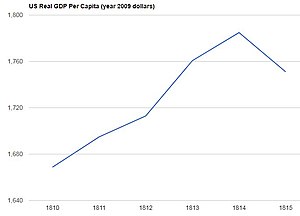
In addition, at least 3,000 American slaves escaped across the British lines. Many other slaves simply escaped in the chaos of war and achieved freedom on their own. The British settled some of the newly freed slaves in Nova Scotia.[272][273] Four hundred freedmen were settled in New Brunswick.[274] The Americans protested that Britain's failure to return the slaves violated the Treaty of Ghent. After arbitration by the Tsar of Russia the British paid $1,204,960 in damages to Washington, to reimburse the slave owners.[275]
In the United States, the economy grew every year from 1812 to 1815, despite a large loss of business by East Coast shipping interests. Prices were 15% higher—inflated—in 1815 compared to 1812, an annual rate of 4.8%.[276] The national economy grew 1812–1815 at 3.7% a year, after accounting for inflation. Per capita GDP grew at 2.2% a year, after accounting for inflation.[271] Hundreds of new banks were opened; they largely handled the loans that financed the war since tax revenues were down. Money that would have been spent on foreign trade was diverted to opening new factories, which were profitable since British factory-made products were not for sale.[277] This gave a major boost to the Industrial Revolution in the United States as typified by the Boston Associates. The Boston Manufacturing Company, built the first integrated spinning and weaving factory in the world at Waltham, Massachusetts in 1813.[278][279]
Long-term consequences
The border between the United States and Canada remained essentially unchanged by the war[lower-alpha 8] and the treaty that ended it addressed the original points of contention—and yet it changed much between the United States and Britain. The Treaty of Ghent established the status quo ante bellum. The issue of impressment became irrelevant when the Royal Navy no longer needed sailors and stopped impressing them.
The long-term results of the war were generally satisfactory to the United States and Britain. Except for occasional border disputes and some tensions during the American Civil War, relations between the United States and Britain remained peaceful for the rest of the 19th century and the two countries became close allies in the 20th century. Historian Troy Bickham argues that each participant defined success in a different way. The new American republic could claim victory in that its independence from London was assured, and the Native American opposition to westward expansion was removed. The memory of the conflict played a major role in helping to consolidate a Canadian national identity after 1867. The British retained Canada, but their attention was overwhelmingly devoted to celebrating the defeat of Napoleon. The consensus is that the tribes were the big losers.[280]
The Rush–Bagot Treaty between the United States and Britain was enacted in 1817. It demilitarized the Great Lakes and Lake Champlain, where many British naval arrangements and forts still remained. The treaty laid the basis for a demilitarized boundary. It remains in effect to this day.
Britain defeated the American invasions of Canada and its own invasion of the United States was defeated in Maryland and New York. After two decades of intense warfare against France, Britain was in no mood for more conflicts with the United States and focused on expanding the British Empire into India. Britain never seriously challenged the United States over land claims after 1846 as it had hoped to keep Texas independent from the United States and had had some hopes of taking California from Mexico. From the 1890s, as the United States emerged as the world's leading industrial power, Britain wanted American friendship in a hypothetical European war. Border adjustments between the United States and British North America were made in the Treaty of 1818. Eastport, Massachusetts was returned to the United States in 1818 and became part of the new State of Maine in 1820. A border dispute along the Maine–New Brunswick border was settled by the 1842 Webster–Ashburton Treaty after the bloodless Aroostook War and the border in the Oregon Country was settled by splitting the disputed area in half by the 1846 Oregon Treaty. A further dispute about the line of the border through the island in the Strait of Juan de Fuca resulted in another almost bloodless standoff in the Pig War of 1859. The line of the border was finally settled by an international arbitration commission in 1872.
Bermuda
Bermuda had been largely left to the defences of its own militia and privateers before American independence, but the Royal Navy had begun buying up land and operating from there in 1795 after an eight years' delay while the surrounding barrier reef was surveyed to discover a channel that would enable large vessels to enter the northern lagoon.[281] Its location made it a useful substitute for the lost United States ports. It originally was intended to be the winter headquarters of the North American Squadron, but in the war it rose to a new prominence. As construction work progressed through the first half of the 19th century, Bermuda became the permanent naval headquarters in Western waters, housing the Admiralty and serving as a base and dockyard. The military garrison was built up to protect the naval establishment, heavily fortifying the archipelago that came to be described as the "Gibraltar of the West". Defence infrastructure remained the central leg of Bermuda's economy until after World War II.[187]
Canadas
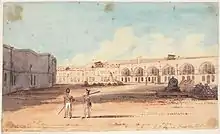
After the war, pro-British leaders in Upper Canada demonstrated a strong hostility to American influences, including republicanism, which shaped its policies.[284] Immigration from the United States was discouraged and favour was shown to the Anglican Church as opposed to the more Americanized Methodist Church.[285]
The Battle of York showed the vulnerability of Upper and Lower Canada. In the decades following the war, several projects were undertaken to improve the defence of the colonies against the United States. They included work on La Citadelle at Quebec City, Fort Henry at Kingston, and rebuilding Fort York at York. Additionally, work began on the Halifax Citadel to defend the port against foreign navies. From 1826 to 1832, the Rideau Canal was built to provide a secure waterway not at risk from American cannon fire. To defend the western end of the canal, the British Army also built Fort Henry at Kingston.[286] Akin to the American view that it was "Second War of Independence" for the United States, the war was also somewhat of a war of independence for Canada.[287]
Indigenous nations
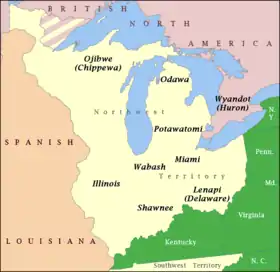
The Native Americans allied to the British lost their cause. The Americans rejected the British proposal to create an "Indian barrier state" in the American West at the Ghent peace conference and it never resurfaced.[288] Donald Fixico argues that "[a]fter the War of 1812, the U.S. negotiated over two hundred Indian treaties that involved the ceding of Indian lands and 99 of these agreements resulted in the creation of reservations west of the Mississippi River".[289]
The indigenous nations lost most of their fur-trapping territory.[290] Indigenous nations were displaced in Alabama, Georgia, New York and Oklahoma, losing most of what is now Indiana, Michigan, Ohio and Wisconsin within the Northwest Territory as well as in New York and the South. They came to be seen as an undesirable burden by British policymakers, who now looked to the United States for markets and raw materials.[291] The United States further disrupted trade along the northern border by prohibiting British fur traders from operating in the United States whereas populations had previously moved freely back and forth across the border before the war.[290]
British agents in the field continued to meet regularly with their indigenous former partners, but they did not supply them with arms or encouragement and the tribes did not attempt any further campaigns to stop American expansionism in the Midwest. Abandoned by their sponsor, American Great Lakes–area Native Americans ultimately migrated or reached accommodations with the American authorities and settlers.[291]
Great Britain
The war is seldom remembered in Great Britain. The massive ongoing conflict in Europe against the French Empire under Napoleon ensured that the British did not consider the War of 1812 against the United States as more than a sideshow.[292] Britain's blockade of French trade had been entirely successful, and the Royal Navy was the world's dominant nautical power (and remained so for another century). While the land campaigns had contributed to saving Canada, the Royal Navy had shut down American commerce, bottled up the United States Navy in port and widely suppressed privateering. British businesses, some affected by rising insurance costs, were demanding peace so that trade could resume with the United States.[293] The peace was generally welcomed by the British, although there was disquiet about the rapid growth of the United States. However, the two nations quickly resumed trade after the end of the war and a growing friendship over time.[294]
Donald Hickey argues that for Britain "the best way to defend Canada was to accommodate the United States. This was the principal rationale for Britain's long-term policy of rapprochement with the United States in the nineteenth century and explains why they were so often willing to sacrifice other imperial interests to keep the republic happy".[295]
United States
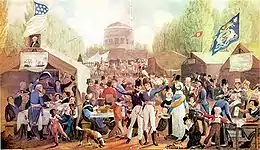
The United States repressed the Native American resistance on its western and southern borders. The nation also gained a psychological sense of complete independence as people celebrated their "second war of independence".[296] Nationalism soared after the victory at the Battle of New Orleans. The opposition Federalist Party collapsed and the Era of Good Feelings ensued.[297]
No longer questioning the need for a strong Navy, the United States built three new 74-gun ships of the line and two new 44-gun frigates shortly after the end of the war.[298] Another frigate had been destroyed to prevent its capture on the stocks. In 1816, the United States Congress passed into law an "Act for the gradual increase of the Navy" at a cost of $1,000,000 a year for eight years, authorizing nine ships of the line and 12 heavy frigates.[300] The captains and commodores of the Navy became the heroes of their generation in the United States. Decorated plates and pitchers of Decatur, Hull, Bainbridge, Lawrence, Perry and Macdonough were made in Staffordshire, England, and found a ready market in the United States. Several war heroes used their fame to win election to national office. Andrew Jackson and William Henry Harrison both took advantage of their military successes to win the presidency while Richard Mentor Johnson used his wartime exploits to attain the vice presidency.
During the war, New England states became increasingly frustrated over how the war was being conducted and how the conflict affected them. They complained that the United States government was not investing enough militarily and financially in the states' defences and that the states should have more control over their militias. Increased taxes, the British blockade, and the occupation of some of New England by enemy forces also agitated public opinion in the states.[301] At the Hartford Convention held between December 1814 and January 1815, Federalist delegates deprecated the war effort and sought more autonomy for the New England states. They did not call for secession but word of the angry anti-war resolutions appeared as peace was announced and the victory at New Orleans was known. The upshot was that the Federalists were permanently discredited and quickly disappeared as a major political force.[302]
This war enabled thousands of slaves to escape to freedom, despite the difficulties. The planters' complacency about slave contentment was shocked at the sight of their slaves fleeing, risking so much to be free. The British helped numerous Black Refugees resettle in New Brunswick and Nova Scotia, where Black Loyalists had also been granted land after the American Revolutionary War.
After the decisive defeat of the Creek Indians at the battle of Horseshoe Bend in 1814, some Creek warriors escaped to join the Seminole in Florida, who had been forming as an ethnic group since the late 18th century. The remaining Creek chiefs signed away about half their lands, comprising 23,000,000 acres, covering much of southern Georgia and two thirds of modern Alabama. The Creek were separated from any future help from the Spanish in Florida and from the Choctaw and Chickasaw to the west. During the war the United States seized Mobile, Alabama, which was a strategic location as it provided an oceanic outlet for export from the cotton lands to the north. Most were yet to be developed, but the United States control of this territory increased pressure on remaining Creek as European Americans began to migrate in number into the area.
Jackson invaded Florida in 1818, demonstrating to Spain that it could no longer control that territory with a small force. Spain sold Florida to the United States in 1819 under the Adams–Onís Treaty following the First Seminole War. Pratt concludes that "[t]hus indirectly the War of 1812 brought about the acquisition of Florida. [...] To both the Northwest and the South, therefore, the War of 1812 brought substantial benefits. It broke the power of the Creek Confederacy and opened to settlement a great province of the future Cotton Kingdom".[303]
Memory and historiography
Popular views
Residents of both the United States and Canada widely believed that their own countries had won the war.[304] Each young country saw its self-perceived victory and settling of the border between them as an important foundation of its growing nationhood. On the other hand, the British, who had been preoccupied by Napoleon's challenge in Europe, paid little attention to what was to them a peripheral and secondary dispute, a distraction from the principal task at hand. According to Kenneth Kidd writing for the Toronto Star in January 2012, "[it has] become axiomatic among historians that Canadians know they won the War of 1812, Americans somehow think they won, and the Indians — who'd continue to cede land to American expansion — definitely know they lost, despite fighting alongside British regulars and Canadian militia".[305]
A popular interpretation, especially in Canada, is that of a British or Canadian win and an American defeat.[306][307][308][309][310] Another popular interpretation, held mainly in the United States, is that of an American win.[32][311][312][313] In a 2012 interview at The Christian Science Monitor, Donald Hickey said: "By my count, we lost the War of 1812 and we lost Vietnam. That's not a widely held opinion in the United States about the War of 1812. The common view is that the war ended in a draw".[306] According to Claire Turenner Solander writing in 2014, "Canadians are unified (because we participated in our diversity in the war under the British Crown, which is our real heritage) and we are distinct from the United States (because we won, and because we are British)".[307] According to Troy Bickham, the American victory at New Orleans "did not have an impact on the war's outcome", but it shaped "how the Americans received the end of the war by creating the illusion of military victory".[314]
American views
While American popular memory includes the British capture and the burning of Washington in August 1814[208] that necessitated its extensive renovation, it focused on the victories at Baltimore, Plattsburgh and New Orleans to present the war as a successful effort to assert American national honour, the "second war of independence" in which the mighty British Empire was humbled and humiliated.[311] In a speech before Congress on 18 February 1815, President James Madison proclaimed the war a complete American victory.[308]
This interpretation of the war was and remains the dominant American view of the war.[308] The American newspaper Niles Register announced in an editorial on 14 September 1816 that the Americans had crushed the British, declaring "we did virtually dictate the treaty of Ghent to the British".[308] A minority of Americans, mostly associated with the Federalists, considered the war a defeat and an act of folly on Madison's part, caustically asking why the British Crown did not cede British North America to the United States, if the Americans were "dictating" the terms of the Treaty of Ghent.[308] However, the Federalist view of the war is not the mainstream American memory of the war.[308] Congressman George Troup, who said in a speech in 1815 that the Treaty of Ghent was "the glorious termination of the most glorious war ever waged by any people", expressed American popular opinion and memory of the war.[308]
Americans also celebrated the successful American defence of Fort McHenry in September 1814, which inspired the lyrics of what was adopted as the United States national anthem, called The Star-Spangled Banner.[315] Captains of the United States Navy became popular heroes, and commemorative plates were produced with the likenesses of Decatur, Issac Hull, and Charles Stewart on them, becoming popular items. Many of these plates were manufactured in England. The navy became a cherished institution, lauded for the victories that it won against all odds.[316] After engagements during the final actions of the war, the United States Marines had acquired a reputation as excellent marksmen, especially in ship-to-ship actions. [317]
Canadian views

In Upper Canada, the War of 1812 was seen by Loyalists as a victory since they had successfully defended their country from an American takeover.[318] A long-term consequence of the Canadian militias' successes was the view, widely held in Canada at least until World War I, that Canada did not need a regular professional army.[319] While Canadian militias had played instrumental roles in several engagements such as at the Battle of the Chateauguay, it was the regular units of the British Army, including the Fencible regiments recruited within British North America, that ensured the successful defence of Canada.
The United States Army had made several attempts to invade Canada and the Canadians had defended their territory. However, the British did not doubt that the thinly populated territory would remain vulnerable in another war. In 1817, Admiral David Milne wrote to a correspondent: "We cannot keep Canada if the Americans declare war against us again".[320] The Rideau Canal was later built for just such a scenario.
By the 21st century, it was a forgotten war in Britain,[321] although still remembered in Canada, especially Ontario. In a 2009 poll, 37% of Canadians said the war was a Canadian victory, 9% said the United States won, 15% called it a draw and 39% said they knew too little to comment.[322] A 2012 poll found that in a list of items that could be used to define Canadians' identity, the belief that Canada successfully repelled an American invasion in the War of 1812 places second (25%).[323]
Historians' views
Militarily, historians hold the view that the war ended in a draw[324][325][326][327] or stalemate,[328][329][330] with the Treaty of Ghent closing a war that had become militarily inconclusive.[331] Neither side wanted to continue fighting since the main causes had disappeared and since there were no large lost territories for one side or the other to reclaim by force. Insofar as they see the war's resolution as allowing two centuries of peaceful and mutually beneficial intercourse between Britain, British Canada and the United States, historians conclude that all three nations were "the real winners" of the War of 1812. Historians also add that the war could have been avoided in the first place by better diplomacy. The war is seen as a mistake for everyone concerned because it was badly planned and marked by multiple fiascos and failures on both sides, especially as shown by the repeated American failures to seize parts of Canada and the failed British attack on New Orleans and upstate New York.[332][333]
As the war does not have a clear winner,[326] historians disagree on who won the War of 1812 and have debated its outcome for nearly two centuries.[326][334] While most historians reach the middle position that it was a draw,[326] there are differing and complex interpretations of the war.[335] A survey of school textbooks found that historians emphasize different aspects of the war according to their national narratives, with some British texts scarcely mentioning the war.[336] According to Donald Hickey, a popular interpretation is that "everyone was happy with the outcome. Americans were happy because they thought they had won: Canadians were happy because they knew they had won; and the British were happiest of all because they quickly forgot about the war. [...] For the British, in other words, the return to status quo ante bellum as a triumph, for it had demonstrated that they could defeat Napoleonic France in Europe while still fending off U.S aggression in North America".[337] Historians who believe that both sides won argue that their main objectives were achieved as Britain defeated Napoleon and ruled the seas while the United States restored its independence and honour and opened the way to westward expansion.[338] While historians such as Wesley Turner held that both sides won, another interpretation held by historians such as Henry Adams came close to suggest that both sides lost.[326]
Historians who hold that the war constituted a British victory and an American defeat argue that the British achieved their military objectives in 1812 by stopping the repeated American invasions of Canada and retaining their Canadian colonies. In contrast, the Americans suffered a defeat when their armies failed to achieve their war goal of seizing part or all of Canada. Additionally, they argue the United States lost as it failed to stop impressment which the British refused to repeal until the end of the Napoleonic Wars, arguing that the American actions had no effect on the Orders in Council which were rescinded before the war started.[311][309] While acknowledging that the war is "usually seen as a draw", Brian Arthur argues that "it was in fact a British victory" because "the British achieved success through an effective commercial maritime blockade which had devastating consequences on the vulnerable, undeveloped US economy".[339] Troy Bickham, author of The Weight of Vengeance: The United States, the British Empire, and the War of 1812, sees the British as having fought to a much stronger position than the United States, writing:
Even tied down by ongoing wars with Napoleonic France, the British had enough capable officers, well-trained men, and equipment to easily defeat a series of American invasions of Canada. In fact, in the opening salvos of the war, the American forces invading Upper Canada were pushed so far back that they ended up surrendering Michigan Territory. The difference between the two navies was even greater. While the Americans famously (shockingly for contemporaries on both sides of the Atlantic) bested British ships in some one-on-one actions at the war's start, the Royal Navy held supremacy throughout the war, blockading the U.S. coastline and ravaging coastal towns, including Washington, D.C. Yet in late 1814, the British offered surprisingly generous peace terms despite having amassed a large invasion force of veteran troops in Canada, naval supremacy in the Atlantic, an opponent that was effectively bankrupt, and an open secessionist movement in New England.[314]
According to Carl Benn, "[t]he main objective of keeping Canada had been met as of 1814" while "Americans realized that their own objectives in going to war could not be achieved, and thought the best they could probably get was the preservation of the status quo that they had been fighting so hard to upset".[311] According to Andrew Lambert, "Americans began to rewrite the war as a victory, exploiting the ambiguity of the diplomatic settlement achieved in the Treaty of Ghent on 24 December 1814, a status quo ante compromise that did not reflect the depth of America's defeat".[340] For Jon Latimer, "Britain was content to settle for the 1812 status quo, and that is what Britain got. The United States, in contrast, achieved none of its war aims, and in these terms, the War of 1812 must be seen as a British victory, however marginal".[309] Bickham considers that the British offered the United States generous terms in place of their initially harsh terms, which included massive forfeiture of land to Canada and the Native Americans, because the "reigning Liverpool ministry in Britain held a loose grip on power and feared the war-weary, tax-exhausted public". For Bickham, the war was also technically a British victory "because the United States failed to achieve the aims listed in its declaration of war".[314] On the other hand, G. M. Trevelyan evaluated the war in negative terms for Britain. He stressed the long-term damage to what has been called the "special relationship" between Britain and the United States, writing: "The self-defence of the two Canadas against invasion, and the historical traditions that the infant nation thus acquired, were an important result of the war. Otherwise it had been fought in vain. It solved none of the disputed questions out of which it arose".[341] According to Trevelyan, "the anti-British tradition had obtained a fresh lease of life in the United States, whose orators now had the theme of a second war against Britain as the second romantic period of their national history. The Tory Cabinet cannot be praised for the management of affairs that led to this breach of the peace".[341]
Historians who believe that it was an American success argue that the main motivation was restoring the nation's honour in the face of relentless British aggression toward American neutral rights on the high seas and in the Western lands. According to Norman K. Risjord, the results in terms of honour satisfied the War Hawks.[32] Donald Hickey asks "Did the cost in blood and treasure justify the U.S. decision to go to war? Most Republicans thought it did. In the beginning they called the contest a 'second war of independence', and while Britain's maritime practices never truly threatened the Republic's independence, the war did in a broad sense vindicate U.S. sovereignty. But it ended in a draw on the battlefield".[312] Historians argue that it was an American success to end the threat of indigenous nations' raids, kill the British plan for a semi-independent Native American sanctuary and hereby to open an unimpeded path for westward expansion.[lower-alpha 10] Winston Churchill concluded: "The lessons of the war were taken to heart. Anti-American feeling in Great Britain ran high for several years, but the United States were never again refused proper treatment as an independent power".[342] George C. Daughan argues that the United States achieved enough of its war goals to claim a victorious result of the conflict and subsequent impact it had on the negotiations in Ghent. Daughan uses official correspondences from President Madison to the delegates at Ghent strictly prohibiting negotiations with regards to maritime law, stating:
Madison's latest dispatches [arrived 25–27 July 1814] permitted [the delegates] to simply ignore the entire question of maritime rights. Free trade with liberated Europe had already been restored, and the Admiralty no longer needed impressment to man its warships. The president felt that with Europe at peace the issues of neutral trading rights and impressment could safely be set aside in the interests of obtaining peace. [...] Thus, from the start of the negotiations, the disagreements that started the war and sustained it were acknowledged by both parties to be no longer important.[343]
For Daughan, the British permanently stopped impressing Americans, although they never publicly rescinded the possibility of resuming that practice. The American delegates at the meeting understood it to be a dead issue after the 1814 surrender of Napoleon.[344] In addition, the successful defence of Baltimore, Plattsburgh and Fort Erie (a strategic fortress located in Upper Canada on the Niagara River and occupied during the third and most successful offensive into Canada) had very favourable influence on the negotiations for the Americans and prompted several famous responses from both sides. Henry Clay wrote to the delegates in October 1814, "for in our own country, my dear sir, at last must we conquer the peace".[345] With growing pressure in Britain, the Duke of Wellington, when asked to command the forces in the United States, wrote to the Earl of Liverpool on 9 November 1814: "I confess that I think you have no right, from the state of the war, to demand any concession of territory from America. [...] You have not been able to carry [the war] [...] into the enemy's territory, notwithstanding your military success and now undoubted military superiority, and have not even cleared your own territory on the point of attack [at Fort Erie]. [...] Why stipulate for uti possidetis?"[346] Daughan argues that the argument the United States failed to capture any Canadian territory influenced the negotiations is an outdated and highly criticized position. He cites the Edinburgh Review, a British newspaper, who had remained silent about the war with the United States for two years, writing that "the British government had embarked on a war of conquest, after the American government had dropped its maritime demands, and the British had lost. It was folly to attempt to invade and conquer the United States. To do so would result in the same tragedy as the first war against them, and with the same result".[347]
According to David Mills, the "militia myth" of Canadian victory was created by the reactionary elites of Upper Canada such as the Family Compact long after the war ended. Most people in Upper Canada were late Loyalists, i.e. economic migrants from the United States, the United Empire Loyalists were not a distinct group, about 10% of the Loyalists were former slaves and most residents did not care who won the war and did not participate in it. The Family Compact disenfranchised most residents of Upper Canada after the war, with the idea of loyalty being used to justify the suppression of dissent. Mills argues that the myth was invented for immigrants who arrived after the end of the Napoleonic Wars. American spelling, which had been standard in the province, was rejected in favour of British spelling, and the local population began to call themselves Canadians.[348]
Indigenous nations as losers
Historians generally agree that the real losers of the War of 1812 were the indigenous nations[324][334][349][350][351] and Tecumseh, whose Confederacy was defeated,[352] arguing:
The big losers in the war were the Indians. As a proportion of their population, they had suffered the heaviest casualties. Worse, they were left without any reliable European allies in North America. [...] The crushing defeats at the Thames and Horseshoe Bend left them at the mercy of the Americans, hastening their confinement to reservations and the decline of their traditional way of life.[353]
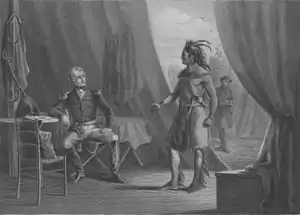
The indigenous nations of the Old Northwest (the modern Midwest) had hoped to create an indigenous state as a British protectorate.[354] American settlers into the Midwest had been repeatedly blocked and threatened by indigenous raids before 1812 and that now came to an end. Throughout the war, the British had played on terror of the tomahawks and scalping knives of their indigenous allies as it worked especially at William Hull's surrender at Detroit. By 1813, Americans had killed Tecumseh and broken his coalition of tribes.[355] Andrew Jackson then defeated the Creek in the Southwest. Historian John Sugden notes that in both theaters, the indigenous nations' strength had been broken prior to the arrival of the major British forces in 1814.[356] The one campaign that the Americans had decisively won was the campaign in the Old Northwest, which put the British in a weak hand to insist upon an indigenous nations' state in the Old Northwest.[354]
Notwithstanding sympathy and support from commanders such as Isaac Brock,[lower-alpha 11] Alexander Cochrane and Edward Nicolls, the policymakers in London reneged on this promise as making peace had a higher priority for the politicians. At the peace conference, the British demanded an independent indigenous state in the Midwest. Although the British and their indigenous allies maintained control over the territories in question (i.e. most of the Upper Midwest), British diplomats did not press the demand after an American refusal, effectively abandoning their allies. The withdrawal of British protection gave the Americans a free hand that resulted in the removal of most of the tribes to Indian Territory (present-day Oklahoma).[357] According to historian Alan Taylor, the final victory at New Orleans had in that sense "enduring and massive consequences".[358] It gave the Americans "continental predominance" while it left the indigenous nations dispossessed, powerless and vulnerable.[359]
The Treaty of Ghent technically required the United States to cease hostilities and "forthwith to restore to such Tribes or Nations respectively all possessions, rights and privileges which they may have enjoyed, or been entitled to in 1811". However, the United States ignored this article of the treaty and proceeded to expand into this territory regardless. Meanwhile, Britain was unwilling to provoke further war to enforce it. A shocked Henry Goulburn, one of the British negotiators at Ghent, remarked: "Till I came here, I had no idea of the fixed determination which there is in the heart of every American to extirpate the Indians and appropriate their territory".[360]
The Creek War came to an end, with the Treaty of Fort Jackson being imposed upon the indigenous nations. About half of the Creek territory was ceded to the United States, with no payment made to the Creeks. This was in theory invalidated by Article 9 of the Treaty of Ghent.[361] The British failed to press the issue and did not take up the indigenous cause as an infringement of an international treaty. Without this support, the indigenous nations' lack of power was apparent and the stage was set for further incursions of territory by the United States in subsequent decades.[362]
See also
Notes
- All United States figures are from Hickey 2006, p. 297.
- Of these, upwards of 800 were killed at sea, 1,160 were British Army regulars and the rest were militia.
- Includes 2,250 men of the Royal Navy.
- Includes 1,000 combat casualties on the northern front.
- Admiralty reply to British press criticism.[152]
- For details of the negotiations, see Samuel Flagg Bemis (1956), John Quincy Adams and the Foundations of American Foreign Policy, pp. 196–220; Remini 1991, pp. 94–122; Ward & Gooch 1922, pp. 537–542 and Mahan 1905, pp. 73–78.
- The British were unsure whether the attack on Baltimore was a failure, but Plattsburg was a humiliation that called for court martial (Latimer 2007, pp. 331, 359, 365).
- Spain, a British ally, lost control of the Mobile, Alabama area to the Americans.
- The soldier is standing, painted gold and dressed as a member of the Royal Newfoundland Regiment Fencible Infantry triumphing over a 16th United States Infantry Regiment.
- The Princeton Encyclopedia of American Political History concludes that "British plans for an American Indian buffer state were dropped, and American Indian nations within U.S. borders lost their last major remaining European diplomatic partner, clearing a path for American westward expansion."[313]
- Sugden (1982, pp. 301–302) mentions that "Brock had urged the British government to protect his Indian allies in peace negotiations, and by the end of 1812 he had obtained from Earl Bathurst, colonial secretary, a promise to that effect."
References
- Clodfelter 2017, p. 245.
- Upton 2003.
- Allen 1996, p. 121.
- Clodfelter 2017, p. 244.
- Leland 2010, p. 2.
- Tucker et al. 2012, p. 311.
- Hickey 2012n.
- Weiss 2013.
- Skaggs 2015, .
- http://www.pbs.org/opb/historydetectives/feature/british-navy-impressment/#:~:text=American%20merchant%20vessels%20were%20a%20common%20target.%20Between,war%20on%20Great%20Britain%2C%20citing%2C%20in%20part%2C%20impressment.
- Ennis, Daniel James (16 December 2002). Enter the Press-gang: Naval Impressment in Eighteenth-century British Literature. University of Delaware Press. ISBN 978-0-87413-755-2 – via Google Books.
- De Kay 2010, p. 32.
- Bickerton & Hagan 2007, p. 32.
- Brunsman et al. 2015, p. 260.
- Woodworth 1812.
- Greespan 2018.
- Hickey 2012, p. 153: "The British blockade had a crushing effect on American foreign trade. "Commerce is becoming very slack," reported a resident of Baltimore in the spring of 1813: "no arrivals from abroad, & nothing going to sea but sharp [that is fast] vessels." By the end of the year, the sea lanes had become so dangerous that merchants wishing to sell goods had to shell out 50 percent of the value of the ship and cargo."
- Carr 1979, p. 273.
- Heidler & Heidler 2002, p. 45.
- Benn 2002, pp. 56–57.
- Order of the Senate of the United States 1828, pp. 619–620.
- Carr 1979, p. 276.
- Anderson 1906.
- Solander 2014.
- Swanson 1945, p. .
- Brands 2005, p. 163.
- Hickey 2013a.
- Goodman 1941, pp. 171–186.
- Egan 1974.
- Silverstone 2004, p. 95.
- Trautsch 2013, pp. 273–293.
- Risjord 1961.
- Lambert 2012.
- Fanis 2011, p. 94.
- Horsman 1962, p. 264.
- Crawford & Dudley 2011, p. 16.
- Toll 2006, p. 281.
- Toll 2006, p. 382.
- Rodger 2005, pp. 565–566.
- Latimer 2007, p. 17.
- Caffrey 1977, p. 60.
- Toll 2006, pp. 278–279.
- Black 2002, p. 44.
- Taylor 2010, p. 104.
- Hooks 2012.
- Hickey 1989, p. 22.
- Hooks 2009, p. ii.
- Deeben 2012.
- White 2010, p. 416.
- Willig 2008, p. 207.
- Benn 2002, p. 18.
- Hitsman 1965, p. 27.
- Heidler & Heidler 1997, pp. 253, 504.
- Zuehlke 2007, p. 62.
- Antal 1998, p. 15.
- Heidler & Heidler 1997, pp. 253, 392.
- Pratt 1955, p. 126.
- Antal 1998, p. 15–16.
- American Military History.
- Smith 1989, pp. 46–63, esp. 61–63.
- Carroll 2001, p. 23.
- Kennedy, Cohen & Bailey 2010, p. 244.
- Brown 1971, p. 129.
- Bowler 1988, pp. 11–32.
- Stagg 1981, pp. 3–34; Stagg 1983, ; Horsman 1962, p. 267; Hickey 1989, p. 72; Brown 1971, p. 128; Burt 1940, pp. 305–310; Stuart 1988, p. 76.
- Stanley 1983, p. 32.
- Heidler & Heidler 2002, p. 4.
- Pratt 1925, pp. 9–15; Hacker 1924, pp. 365–395; Hickey 1989, p. 47; Carlisle & Golson 2007, p. 44; Stagg 2012, pp. 5–6; Tucker 2011, p. 236.
- Nugent 2008, pp. 73–75.
- Langguth 2006, p. 262.
- Benn 2002, p. 16.
- Berton 2001, p. 206.
- Hickey 2012, p. 68.
- Nugent 2008, p. 75.
- Benn & Marston 2006.
- Heller 2010, p. 98.
- Horsman 1987, p. 13.
- Maass 2014, pp. 70–97.
- Horsman 1987.
- Horsman 1987, p. 14: He quotes Madison in "the (military) success on the public mind may mean would make it 'difficult to relinguish territory that which had been conquered.'"
- Taylor 2010, pp. 137–139.
- Heidler & Heidler 2003, p. 9.
- Taylor 2010, p. .
- Hickey 1978, pp. 23–39.
- Banner 1970.
- Grodzinski 2013, p. 69.
- Benn 2002, p. 20.
- Benn 2002, pp. 20–21.
- Benn 2002, pp. 20 & 54–55.
- Benn 2002, p. 21.
- Barney 2019.
- Crawford & Dudley 2011, p. 268.
- Hitsman 1965, p. 295.
- Elting 1995, p. 11.
- Starkey 2002, p. 18.
- Starkey 2002, p. 20.
- Carstens & Sanford 2011, p. 53.
- Benn 2002, p. 25.
- Summer 1812: Congress.
- Clymer 1991.
- Gilje 1980, p. 551.
- Toll 2006, p. 329.
- Proclamation: Province of Upper Canada 1812.
- Turner 2011, p. 311.
- Battle of Mackinac.
- Hannay 1911, p. 847.
- Hickey 1989, pp. 72–75.
- Quimby 1997, pp. 2–12.
- Dauber 2003, p. 301.
- Adams 1918, p. 400.
- Hickey 1989, p. 80.
- Heidler & Heidler 1997, pp. 233–234, 349–350, 478–479.
- History of Sandwich.
- Benn & Marston 2006, p. 214.
- Auchinleck 1855, p. 49.
- Laxer 2012, p. 131.
- Aprill 2015.
- Clarke Historical Library.
- Laxer 2012, pp. 139–142.
- Rosentreter 2003, p. 74.
- Marsh 2011.
- Hannings 2012, p. 50.
- Hickey 1989, p. 84.
- Hannay 1911, p. 848.
- We Have Met.
- National Guard History eMuseum.
- Benn 2002, p. 37.
- Benn 2002, p. 40.
- Ridler 2015.
- Benn 2002, p. 41.
- Benn 2002, p. 44.
- Malcomson 1998.
- Historic Lewiston, New.
- Prohaska 2010.
- Benn 2002, p. 45.
- Benn 2002, p. 47.
- Benn 2002, p. 48.
- Benn 2002, p. 49.
- Benn 2002, p. 51.
- Benn 2002, p. 52.
- Grodzinski 2010, pp. 560–561.
- Burroughs 1983.
- Rodriguez 2002, p. 270.
- Cole 1921, pp. 69–74.
- Nolan 2009, pp. 85–94.
- Concise Historical Atlas 1998, p. 85.
- Stevens 1921, pp. 480–482.
- Elting 1995, p. 323.
- First United States.
- Toll 2006, p. 180.
- Gwyn 2003, p. 134.
- Toll 2006, p. 50.
- Arthur 2011, p. 73.
- Black 2008.
- Toll 2006.
- James 1817.
- Gardiner 2000, p. .
- Toll 2006, pp. 360–365.
- Roosevelt 1882.
- Gardiner 1998, p. 162.
- Gardiner 1998, p. 164.
- Gardiner 1998, p. 163.
- Gardiner 1998, p. : "The survey of the ship was complimentary about the build-quality of the ship, but thought the scantlings to be oversize: she had originally been intended as another 44, and it is possible that the timbers collected for the original design were not reduced in siding for the smaller revised dimensions."
- Forester 1970, pp. 131–132.
- Gardiner 1998, p. 61.
- Essex 1991.
- Gardiner 1998, p. : "Not only did this ship register the highest speed of in any of the reports of the period — 14.4kts large — but was widely regarded as the benchmark for frigate performance for half a century."
- Lambert 2012, p. 102.
- Benn 2002, p. 55.
- American Merchant Marine.
- Franklin.
- Brewer 2004.
- Latimer 2007, p. 242.
- Kert 2015, p. 146.
- Lambert 2012, pp. 394–395.
- Stranack 1990, p. .
- Faye 1997, p. 171.
- Grodzinski 2011.
- Hannay 1911, p. 849.
- Benn 2002, pp. 55–56.
- Benn 2002, p. 56.
- Leckie 1998, p. 255.
- Benn 2002, p. 57.
- Riggs 2015, pp. 1446–1449.
- Stranack 1990, p. .
- Whitfield 2006, p. 25.
- Malcomson 2012, p. 366.
- Bermingham 2003.
- Black Sailors Soldiers 2012.
- The Royal Gazette 2016.
- Smith 2011, pp. 75–91.
- Kilby 1888, p. 79.
- Smith 2007, pp. 81–94.
- Kilby 1888, p. 80.
- Harvey 1938, pp. 207–213.
- Connolly 2018.
- DeCosta-Klipa 2018.
- Webed 2013, p. 126.
- "Robert Ross". NPS. Retrieved 17 January 2021.
- "In 1814, British forces burned the U.S. Capitol". Washington Post. Retrieved 16 January 2021.
- "Interview With War of 1812 Author Steve Vogel". History Net. 13 June 2013. Retrieved 17 January 2021.
- "Trump blames Canada for torching White House. Meet the 'reluctant arsonist'". CBC News. 18 June 2018. Retrieved 16 January 2021.
- "Why Americans Celebrate the Burning of Washington". TIME magazine. Retrieved 16 January 2021.
Cockburn, who accompanied Ross into the capital, reportedly wanted to burn the entire city in retaliation for American depredations in Canada. But it was an army operation and Ross’ call, and he would have none of it.
- "The British Burn Washington, D.C., 200 Years Ago". History.com. 29 August June 2018. Retrieved 16 January 2021. Check date values in:
|date=(help) - "Five myths about the burning of Washington". Washington Post. 28 June 2013. Retrieved 16 January 2021.
- Defense Burning of.
- Herrick 2005, p. 90.
- Benn 2002, p. 59.
- Webed 2013, p. 129.
- Coleman 2015, pp. 599–629.
- Millett 2013.
- Wilentz 2005, pp. 23–25.
- Braund 1993.
- Hurt 2002.
- Remini 1977, p. 72.
- Adams 1918, p. 785.
- Waselkov 2009, p. .
- Braund 2012.
- Remini 2002, pp. 70–73.
- Adams 1918, pp. 791–793.
- Remini 1977, p. 213.
- Hickey 1989, pp. 146–151.
- Bunn & Williams 2008.
- HMS Carron.
- Sugden 1982, p. 285.
- Sugden 1982, pp. 286–287.
- Heidler & Heidler 1997, pp. 409–11.
- Sugden 1982, p. 297.
- Tucker et al. 2012, p. 229.
- McPherson 2013, p. 699.
- Introduction: War of 1812.
- Chartrand 2012, p. 27.
- Owsley 2000.
- Reilly 1974, pp. 303, 306.
- Remini 1999, p. 167.
- Remini 1999, pp. 136–83.
- Stewart 2005.
- Remini 1999, p. 181.
- Owsley 1972, p. 36.
- Frazer & Carr Laughton 1930, p. 294.
- Bullard 1983, p. .
- Hickey 1989, p. ; Daughan 2011, p. ; Lambert 2012, p. 399.
- Hickey 1989, p. 231.
- Morison 1941, pp. 205–206.
- Benn 2002, pp. 75–76.
- Hickey 1989, pp. 217–218.
- Latimer 2007, pp. 362–365.
- Remini 1991, p. 117.
- Mahan 1905, pp. 73–78.
- Ward & Gooch 1922, p. 540.
- Perkins 1964, pp. 108–109; Hickey 2006, pp. 150–151; Hibbert 1997, p. 164.
- Mills 1921, pp. 19–32; Toll 2006, p. 441.
- Latimer 2007, pp. 389–391; Gash 1984, pp. 111–119.
- Mahan 1905.
- Updyke 1915, p. 360.
- Perkins 1964, pp. 129–130.
- Hickey 2006, p. 295.
- Anguth 2006, p. 375.
- Heidler & Heidler 1997, pp. 208–209.
- Anguth 2006, p. 374–375.
- Tucker 2012, p. 113.
- Hickey 2006, p. 297.
- Latimer 2007, p. 389.
- Adams 1918, p. 385.
- Hickey 1989, p. 303.
- Adams 1978.
- MacDowell 1900, pp. 315–316.
- Kert 2015, p. 145.
- Johnston & Williamson 2019.
- African Nova Scotians.
- Whitfield 2005.
- Black Loyalists in New Brunswick.
- Taylor 2010, p. 432.
- $100 in 1812.
- Nettels 2017, pp. 35–40.
- Bergquist 1973, pp. 45–55.
- Morales 2009.
- Bickham 2012, pp. 262–280.
- Jones 2016.
- Akenson 1999, p. 137.
- Landon 1941, p. 123.
- Hayes 2008, p. 117.
- O'Grady 2008, p. 892: "[H]owever stupid a war it was, was something of a war of independence for Canada. It meant that Canada was going to go its own way."
- Hatter 2016, p. 213.
- Fixico.
- Berthier-Foglar & Otto 2020, p. 26.
- Calloway 1986, pp. 1–20.
- Hickey 1989, p. 304.
- Heidler & Heidler 2002, p. 7; Latimer 2009, p. 88.
- Stearns 2008, p. 547.
- Hickey 2014.
- Langguth 2006; Cogliano 2008, p. 247.
- Dangerfield 1952, pp. xi–xiii, 95.
- Toll 2006, pp. 456, 467.
- Toll 2006, p. 457.
- Hickey 1989, p. 255ff.
- Cogliano 2008, p. 234.
- Pratt 1955, p. 138.
- Buckner 2008, pp. 47–48.
- Kidd 2012.
- Dotinga & Hickey 2012.
- Solander 2014, p. 166.
- Benn 2002, p. 83.
- Latimer 2007, p. 3.
- Boswell 2011.
- Benn 2002, pp. 82–83.
- Hickey 2013, Introduction.
- Princeton Encyclopedia of American Political History, p. 343.
- Bickham 2017.
- Star-Spangled Banner.
- Toll 2006, p. 456.
- Simmons 2003.
- Kaufman 1997, pp. 110–135.
- Cmh: Origins of 2007.
- Toll 2006, pp. 458–459.
- Lambert 2012, p. 1.
- Boswell 2009.
- Ipsos Reid.
- Howe 2007, p. 74: "Considered as a conflict between Great Britain and the United States, the War of 1812 was a draw. For the Native Americans, however, it constituted a decisive defeat with lasting consequences."
- Hickey 2012, p. 228: "Thus, after three years of campaigning, neither the United States nor Great Britain could claim any great advantage in the war, let alone victory. Militarily, the War of 1812 ended in a draw."
- Clark & Hickey 2015, p. 103.
- Coles 2018, p. 255: "Militarily the War of 1812 was a draw."
- Carroll 1997: "The War of 1812 also had an impact on the border. A decisive military victory by either the United States or His Majesty's forces, might well have settled the boundary controversy once and for all, but by and large the war was fought to a stalemate."
- Heidler & Heidler 2002, p. 137: "Britain finally accepted stalemate as the best bargain. The American delegation wisely did so as well."
- Waselkov 2009, p. 177: "New Orleans [...] retrieved the nation's honor and brought the war to close as a virtual stalemate."
- USS Constitution Museum: "Ultimately, the War of 1812 ended in a draw on the battlefield, and the peace treaty reflected this."
- Heidler & Heidler 2002, p. 135–137.
- Howe 2007, p. 73–75.
- Kohler 2013, p. 316: "While the debate about 'who won the war' continues, most historians agree that the clear loser was the First Nations/Native Americans."
- Trautsch 2014.
- Mowat 1965, p. 35.
- Hickey 2012, p. 306.
- Turner 2000.
- Arthur 2011.
- Lambert 2016, p. 303.
- Trevelyan 1901, p. 177.
- Churchill 1958, p. 366.
- Daughan 2011, p. 328.
- Rutland 1994, p. 200.
- Daughan 2011, p. 353.
- Mills 1921, pp. 19–32.
- Daughan 2011, p. 359.
- Mills 1988.
- Thompson & Randall 2008, p. 23.
- Bowman & Greenblatt 2003, p. 142.
- Kessel & Wooster 2005, p. 145.
- Smelser 1969, p. 43.
- Hickey 2013, p. 34, Introduction.
- Benn 2002, p. 85.
- Sugden 1990.
- Sugden 1982, p. 311.
- Taylor 2010, pp. 435–439.
- Taylor 2010, p. 421.
- Taylor 2010, p. 437.
- Treaty of Ghent.
- Sugden 1982, p. 304.
- Sugden 1982, pp. 273–274.
Sources
- "$100 in 1812 → 1815 – Inflation Calculator". Officialdata.org. Retrieved 8 February 2019.
- Adams, Donald R. (1978). "A Study of Stephen Girard's Bank, 1812–1831". Finance and enterprise in early America: a study of Stephen Girard's bank, 1812–1831. University of Pennsylvania Press. ISBN 978-0-8122-7736-4. JSTOR j.ctv4t814d.
- Adams, Henry (1918) [1891]. History of the United States of America during the Administrations of James Madison and Thomas Jefferson. II: History of the United States During the First Administration of James Madison. New York: Scribner & Sons. ISBN 0-940450-35-6.
- "African Nova Scotians in the Age of Slavery and Abolition". Government of Nova Scotia Programs, services and information.
- Akenson, Donald Harman (1999). The Irish in Ontario: A Study in Rural History. McGill-Queens. ISBN 978-0-7735-2029-5.
- Allen, Robert S. (1996). "Chapter 5: Renewing the Chain of Friendship". His Majesty's Indian allies: British Indian policy in the defence of Canada, 1774–1815. Toronto: Dundurn Press. ISBN 1-55002-175-3.
- "American Merchant Marine and Privateers in War of 1812". Usmm.org. Retrieved 8 February 2019.
- "American Military History, Army Historical Series, Chapter 6". Retrieved 1 July 2013.
- Anguth, A. J. (2006). Union 1812: The Americans who fought the Second War of Independence (illustrated ed.). Simon and Schuster. ISBN 978-0-7432-2618-9.
- Anderson, Chandler Parsons (1906). Northern Boundary of the United States: The Demarcation of the Boundary Between the United States and Canada, from the Atlantic to the Pacific, with Particular Reference to the Portions Thereof which Require More Complete Definition and Marking: Report. United States Government Printing Office. Retrieved 25 July 2020.
- Antal, Sandy (1998). Wampum Denied: Procter's War of 1812. McGill-Queen's University Press.
- Aprill, Alex (October 2015). "General William Hull". Michigan Tech.
- Army and Navy Journal Incorporated (1865). The United States Army and Navy Journal and Gazette of the Regular and Volunteer Forces. 3. Princeton University.
- Arnold, James R.; Frederiksen, John C.; Pierpaoli Jr., Paul G.; Tucker, Spener C.; Wiener, Roberta (2012). The Encyclopedia of the War of 1812: A Political, Social, and Military History. Santa Barbara, California: ABC-CLIO. ISBN 978-1-85109-956-6.
- Arthur, Brian (2011). How Britain Won the War of 1812: The Royal Navy's Blockades of the United States. Boydell Press. ISBN 978-1-84383-665-0.
- Auchinleck, Gilbert (1855). A History of the War Between Great Britain and the United States of America: During the Years 1812, 1813, and 1814. Maclear & Company. p. 49.
- Banner, James M. (1970). To the Hartford Convention: The Federalists and the Origins of Party Politics in Massachusetts, 1789–1815. New York: Knopf.
- Barney, Jason (2019). Northern Vermont in the War of 1812. Charleston, South Carolina. ISBN 978-1-4671-4169-7. OCLC 1090854645.
- "Battle of Mackinac Island, 17 July 1812". HistoryofWar.org. Retrieved 23 May 2017.
- Benn, Carl (2002). The War of 1812. Oxford: Osprey Publishing. ISBN 978-1-84176-466-5.
- Benn, Carl; Marston, Daniel (2006). Liberty or Death: Wars That Forged a Nation. Oxford: Osprey Publishing. ISBN 1-84603-022-6.
- Bergquist, H. E. Jr. (1973). "The Boston Manufacturing Company and Anglo-American relations 1807–1820". Business History. 15 (1): 45–55. doi:10.1080/00076797300000003.
- Bermingham, Andrew P. (2003). Bermuda Military Rarities. Bermuda Historical Society; Bermuda National Trust. ISBN 978-0-9697893-2-1.
- "Bermuda Dockyard and the War of 1812 Conference". United States Naval Historical Foundation. 7–12 June 2012. Retrieved 31 July 2020.
- Berthier-Foglar, Susanne; Otto, Paul (2020). Permeable Borders: History, Theory, Policy, and Practice in the United States. Berghahn Books. ISBN 978-1-78920-443-8.
- Berton, Pierre (2001) [1981]. Flames Across the Border: 1813–1814. ISBN 0-385-65838-9.
- Bickham, Troy (2012). The Weight of Vengeance: The United States, the British Empire, and the War of 1812. Oxford University Press. ISBN 978-0-19-994262-6.
- Bickham, Troy (15 July 2017). "Should we still care about the War of 1812?". OUPblog. Oxford University Press.
- Bickerton, Ian J.; Hagan, Kenneth J. (2007). Unintended Consequences: The United States at War. Reaktion Books. ISBN 978-1-86189-512-7.
- "Black History Month: British Corps of Colonial Marines (1808-1810, 1814-1816)". The Royal Gazette. City of Hamilton, Bermuda. 12 February 2016. Retrieved 29 July 2020.
- "Black Sailors and Soldiers in the War of 1812". War of 1812. PBS. 2012. Retrieved 1 October 2014.
- Black, Jeremy (2002). America as a Military Power: From the American Revolution to the Civil War. Westport, Connecticut: Praeger.
- Black, Jeremy (August 2008). "A British View of the Naval War of 1812". Naval History Magazine. Vol. 22 no. 4. U.S. Naval Institute. Retrieved 22 March 2017.
- "Black Loyalists in New Brunswick, 1789–1853". Atlanticportal.hil.unb.ca. Atlantic Canada Portal, University of New Brunswick. Retrieved 8 February 2019.
- Boswell, Randy (9 December 2009). "Who won War of 1812 baffles poll respondents". Canwest News Service.
- Boswell, Randy (27 November 2011). "Canada Won the war of 1812, US Historian admits". National Post. Retrieved 31 July 2020.
- Bowler, R Arthur (March 1988). "Propaganda in Upper Canada in the War of 1812". American Review of Canadian Studies. 18 (1): 11–32. doi:10.1080/02722018809480915.
- Bowman, John Stewart; Greenblatt, Miriam (2003). War of 1812. Infobase Publishing. ISBN 978-1-4381-0016-6.
- Brands, H. W. (2005). Andrew Jackson: His Life and Times. Random House Digital. ISBN 978-1-4000-3072-9.
- Braund, Kathryn E. Holland (1993). Deerskins & Duffels: The Creek Indian Trade with Anglo-America, 1685-1815. University of Nebraska Press. ISBN 978-0-8032-1226-8.
- Braund, Kathryn E. Holland (2012). Tohopeka: Rethinking the Creek War and the War of 1812. University of Alabama Press. ISBN 978-0-8173-5711-5.
- Brewer, D. L. III (May 2004). "Merchant Mariners – America's unsung heroes". Sealift. Military Sealift Command. Archived from the original on 12 August 2004. Retrieved 22 October 2008.
- Brown, Roger H. (1971). The Republic in Peril (illustrated ed.). Norton. ISBN 978-0-393-00578-3.
- Brunsman, Denver; Hämäläinen, Pekka; Johnson, Paul E.; McPherson, James M.; Murrin, John M. (2015). Liberty, Equality, Power: A History of the American People, Volume 1: To 1877. Cengage Learning. ISBN 978-1-305-68633-5.
- Buckner, Phillip Alfred (2008). Canada and the British Empire. Oxford University Press. pp. 47–48. ISBN 978-0-19-927164-1.
- Bullard, Mary Ricketson (1983). Black Liberation on Cumberland Island in 1815. M. R. Bullard.
- Bunn, Mike; Williams, Clay (2008). Battle for the Southern Frontier: The Creek War and the War of 1812. Arcadia Publishing Incorporated. ISBN 978-1-62584-381-4.
- Burroughs, Peter (1983). "Prevost, Sir George". In Halpenny, Francess G (ed.). Dictionary of Canadian Biography. V (1801–1820) (online ed.). University of Toronto Press.
- Burt, Alfred LeRoy (1940). The United States, Great Britain and British North America from the revolution to the establishment of peace after the war of 1812. Yale University Press.
- Caffrey, Kate (1977). The Twilight's Last Gleaming: Britain vs. America 1812–1815. New York: Stein and Day. ISBN 0-8128-1920-9.
- Calloway, Colin G. (1986). "The End of an Era: British-Indian Relations in the Great Lakes Region after the War of 1812". Michigan Historical Review. 12 (2): 1–20. doi:10.2307/20173078. JSTOR 20173078.
- Carlisle, Rodney P.; Golson, J. Geoffrey (1 February 2007). Manifest Destiny and the Expansion of America. ABC-CLIO. ISBN 978-1-85109-833-0.
- Carr, J. A. (July 1979). "The Battle of New Orleans and the Treaty of Ghent". Diplomatic History. 3 (3): 273–282. doi:10.1111/j.1467-7709.1979.tb00315.x.
- Carroll, Francis M. (2001). A Good and Wise Measure: The Search for the Canadian-American Boundary, 1783–1842. Toronto: University of Toronto. p. 24. ISBN 978-0-8020-8358-6.
- Carroll, Francis M. (March 1997). "The Passionate Canadians: The Historical Debate about the Eastern Canadian-American Boundary". The New England Quarterly. 70 (1): 83–101. doi:10.2307/366528. JSTOR 366528.
- Carstens, Patrick Richard; Sanford, Timothy L. (2011). Searching for the Forgotten War - 1812 Canada. Toronto: University of Toronto Press. ISBN 978-1-4535-8892-5.
- Chartrand, René (2012). Forts of the War of 1812. Bloomsbury Publishing. ISBN 978-1-78096-038-8.
- Churchill, Winston (1958). A History of the English-Speaking Peoples. 3.
- Clark, Connie D.; Hickey, Donald R., eds. (2015). The Routledge Handbook of the War of 1812. Routledge. ISBN 978-1-317-70198-9.
- Clarke Historical Library. "The War of 1812". Central Michigan University.
- Clodfelter, M. (2017). Warfare and Armed Conflicts: A Statistical Encyclopedia of Casualty and Other Figures, 1492–2015 (4th ed.). Jefferson, North Carolina: McFarland.
- Clymer, Adam (13 January 1991). "Confrontation in the Gulf; Congress acts to authorize war in Gulf; Margins are 5 votes in Senate, 67 in House". The New York Times. Retrieved 30 July 2017.
- "CMH: Origins of the Militia Myth". Cdnmilitary.ca. 26 May 2007. Archived from the original on 4 May 2008.
- Cogliano, Francis D. (2008). Revolutionary America, 1763–1815: A Political History (2nd ed.). Routledge. ISBN 978-0-415-96486-9.
- Cole, Cyrenus (1921). A History of the People of Iowa. Cedar Rapids, Iowa: The Torch press. ISBN 978-1-378-51025-4.
- Coleman, William (Winter 2015). "'The Music of a well tun'd State': 'The Star Spangled Banner' and the Development of a Federalist Musical Tradition". Journal of the Early Republic. 35 (4): 599–629. doi:10.1353/jer.2015.0063. S2CID 146831812.
- Coles, Harry L. (2018). The War of 1812. University of Chicago Press. ISBN 978-0-226-22029-1.
- "Come and discover more about the fortress once known as the Gibraltar of the West". Royal Naval Dockyard, Bermuda. Retrieved 31 July 2020.
- Connolly, Amanda (5 July 2018). "What's Driving the Dispute over U.S. Border Patrols and Canadian fishermen around Machias Seal Island?". Global News. Retrieved 25 July 2020.
- Crawford, Micheal J.; Dudley, William S., eds. (2011). The Naval War of 1812: A Documentary History. 1. Military Bookshop. ISBN 978-1-78039-364-3.
- Dangerfield, George (1952). The Era of Good Feelings. Harcourt, Brace. ISBN 978-0-929587-14-1.
- Dauber, Michele L. (2003). "The War of 1812, September 11th, and the Politics of Compensation". DePaul Law Review. 53 (2): 289–354.
- Daughan, George C. (2011). 1812: The Navy's War. New York: Basic Books. ISBN 978-0-465-02046-1.
- Dean, William G.; Heidenreich, Conrad; McIlwraith, Thomas F.; Warkentin, John, eds. (1998). "Plate 38". Concise Historical Atlas of Canada. Illustrated by Geoffrey J. Matthews and Byron Moldofsky. University of Toronto Press. p. 85. ISBN 978-0-802-04203-3.
- DeCosta-Klipa, Nik (22 July 2018). "The Long, Strange History of the Machias Seal Island Dispute". Boston.com. Retrieved 25 July 2020.
- Deeben, John P. (Summer 2012). "The War of 1812 Stoking the Fires: The Impressment of Seaman Charles Davis by the U.S. Navy". Prologue Magazine. Vol. 44 no. 2. U.S. National Archives and Records Administration. Retrieved 1 October 2014.
- "The Defense and Burning of Washington in 1814: Naval Documents of the War of 1812". Navy Department Library. U.S. Naval History & Heritage Command. Archived from the original on 2 July 2013. Retrieved 23 June 2013.
- De Kay, James Tertius (2010). A Rage for Glory: The Life of Commodore Stephen Decatur, USN. Simon and Schuster. ISBN 978-1-4391-1929-7.
- Dotinga, Randy; Hickey, Donald R. (8 June 2012). "Why America forgets the War of 1812". The Christian Science Monitor. Retrieved 16 July 2020.
- Edwards, Rebecca; Kazin, Michael; Rothman, Adam, eds. (2009). The Princeton Encyclopedia of American Political History. Princeton University Press. ISBN 978-1-4008-3356-6.
- Egan, Clifford L. (April 1974). "The Origins of the War of 1812: Three Decades of Historical Writing". Military Affairs. 38 (2): 72–75. doi:10.2307/1987240. JSTOR 1987240.
- Elting, John R. (1995). Amateurs to Arms. New York: Da Capo Press. ISBN 0-306-80653-3.
- "Essex". Dictionary of American Naval Fighting Ships (DANFS). Washington, DC: Naval Historical Center. 1991.
- Fanis, Maria (2011). Secular Morality and International Security: American and British Decisions about War. Ann Harbor, Michigan: University of Michigan Press. ISBN 978-0-472-11755-0.
- Faye, Kert (1997). Prize and Prejudice Privateering and Naval Prize in Atlantic Canada in the War of 1812. St. John's, Nfld: International Maritime Economic History Association.
- "First United States Infantry". Iaw.on.ca. Archived from the original on 28 July 2012. Retrieved 27 August 2012.
- Fixico, Donald. "A Native Nations Perspective on the War of 1812". The War of 1812. PBS. Retrieved 2 January 2021.
- Forester, C. S. (1970) [1957]. The Age of Fighting Sail. New English Library. ISBN 0-939218-06-2.
- Franklin, Robert E. "Prince de Neufchatel". Archived from the original on 6 December 2004. Retrieved 26 July 2010.CS1 maint: unfit URL (link)
- Frazer, Edward; Carr Laughton, L. G. (1930). The Royal Marine Artillery 1803–1923. 1. London: Royal United Services Institution. OCLC 4986867.
- Gardiner, Robert, ed. (1998). The Naval War of 1812: Caxton pictorial history. Caxton Editions. ISBN 1-84067-360-5.
- Gardiner, Robert (2000). Frigates of the Napoleonic Wars. London: Chatham Publishing.
- Gash, Norman (1984). Lord Liverpool: The Life and Political Career of Robert Banks Jenkinson, Second Earl of Liverpool, 1770–1828. Weidenfeld and Nicolson. ISBN 0-297-78453-6.
- Gilje, Paul A. (1980). "The Baltimore Riots of 1812 and the Breakdown of the Anglo-American Mob Tradition". Journal of Social History. Oxford University Press. 13 (4): 547–564. doi:10.1353/jsh/13.4.547. JSTOR 3787432.
- Goodman, Warren H. (1941). "The Origins of the War of 1812: A Survey of Changing Interpretations". Mississippi Valley Historical Review. 28 (2): 171–186. doi:10.2307/1896211. JSTOR 3738032.
- Greespan, Jesse (29 August 2018). "How U.S. Forces Failed to Capture Canada 200 Years Ago". History.com. Retrieved 20 July 2020.
- Grodzinski, John R. (September 2010). "Review". Canadian Historical Review. 91 (3): 560–561. doi:10.1353/can.2010.0011. S2CID 162344983.
- Grodzinski, John R. (27 March 2011). "Atlantic Campaign of the War of 1812". War of 1812. Archived from the original on 27 October 2016. Retrieved 26 October 2016. From the Canadian Encyclopedia.
- Grodzinski, John R. (2013). Defender of Canada: Sir George Prevost and the War of 1812. University of Oklahoma Press. ISBN 978-0-8061-5071-0.
- Gwyn, Julian (2003). Frigates and Foremasts: The North American Squadron in Nova Scotian Waters, 1745–1815. UBC Press.
- "HMS Carron". Pbenyon.plus.com. Retrieved 11 November 2013.
- Hacker, Louis M. (March 1924). "Western Land Hunger and the War of 1812: A Conjecture". Mississippi Valley Historical Review. X (4): 365–395. doi:10.2307/1892931. JSTOR 1892931.
- Hannay, David (1911). . In Chisholm, Hugh (ed.). Encyclopædia Britannica. 1 (11th ed.). Cambridge University Press.
- Hannings, Bud (2012). The War of 1812: A Complete Chronology with Biographies of 63 General Officers. McFarland Publishing. p. 50. ISBN 978-0-7864-6385-5.
- Harvey, D. C. (July 1938). "The Halifax–Castine expedition". Dalhousie Review. 18 (2): 207–213.
- Hatter, Lawrence B. A. (2016). Citizens of Convenience: The Imperial Origins of American Nationhood on the U.S.-Canadian Border. University of Virginia Press. ISBN 978-0-8139-3955-1.
- Hayes, Derek (2008). Canada: An Illustrated History. Douglas & McIntyre. ISBN 978-1-55365-259-5.
- Heidler, David S.; Heidler, Jeanne T., eds. (1997). Encyclopedia of the War of 1812. Naval Institute Press. ISBN 0-87436-968-1.
- Heidler, David S.; Heidler, Jeanne T. (2002). The War of 1812. Westport; London: Greenwood Press. ISBN 0-313-31687-2.
- Heidler, David S.; Heidler, Jeanne T. (2003). Manifest Destiny. Greenwood Press.
- Heller, John Roderick (2010). Democracy's Lawyer: Felix Grundy of the Old Southwest. ISBN 978-0-8071-3742-0.
- Herrick, Carole L. (2005). August 24, 1814: Washington in Flames. Falls Church, Virginia: Higher Education Publications. ISBN 0-914927-50-7.
- Hibbert, Christopher (1997). Wellington: A Personal History. Reading, Massachusetts: Perseus Books. ISBN 0-7382-0148-0.
- Hickey, Donald R. (1978). "Federalist Party Unity and the War of 1812". Journal of American Studies. 12 (1): 23–39. doi:10.1017/S0021875800006162.
- Hickey, Donald R. (1989). The War of 1812: A Forgotten Conflict. Urbana; Chicago: University of Illinois Press. ISBN 0-252-01613-0.
- Hickey, Donald R. (2006). Don't Give Up the Ship! Myths of The War of 1812. Urbana: University of Illinois Press. ISBN 978-0-252-03179-3.
- Hickey, Donald R. (2012y). The War of 1812: A Forgotten Conflict. University of Illinois Press. ISBN 978-0-252-09373-9.
- Hickey, Donald R. (2012z). The War of 1812, A Short History. University of Illinois Press. ISBN 978-0-252-09447-7.
- Hickey, Donald R. (November 2012n). "Small War, Big Consequences: Why 1812 Still Matters". Foreign Affairs. Council on Foreign Relations. Archived from the original on 16 January 2013. Retrieved 26 July 2014.
- Hickey, Donald R., ed. (2013). The War of 1812: Writings from America's Second War of Independence. Library of America. New York: Literary Classics of the United States. ISBN 978-1-59853-195-4.
- Hickey, Donald R. (September 2013a). "1812: The Old History and the New". Reviews in American History. 41 (3): 436–444. doi:10.1353/rah.2013.0081. S2CID 144136235.
- Hickey, Donald R. (2014). "The Bully Has Been Disgraced by an Infant'—The Naval War of 1812". Review of Utmost Gallantry: The U.S. and Royal Navies at Sea in the War of 1812 in the War of 1812 and Challenge: America, Britain and the War of 1812" (PDF). Michigan War Studies Review.
- "Historic Lewinston, New York". Historical Association of Lewiston. Archived from the original on 10 October 2010. Retrieved 12 October 2010.
- "History of Sandwich". City of Winsdor. Retrieved 16 July 2020.
- Hitsman, J. Mackay (1965). The Incredible War of 1812. Toronto: University of Toronto Press.
- Hooks, J. W. (2009). "A friendly salute: The President-Little Belt Affair and the coming of the war of 1812 (PDF) (PhD). University of Alabama. p. ii. Retrieved 5 June 2018.
- Hooks, J. (2012). "Redeemed honor: the President-Little Belt Affair and the coming of the war of 1812". The Historian. 1 (1).
- Horsman, Reginald (1962). The Causes of the War of 1812. Philadelphia: University of Pennsylvania Press. ISBN 0-498-04087-9.
- Horsman, Reginald (1987). "On to Canada: Manifest Destiny and United States Strategy in the War of 1812". Michigan Historical Review. 13 (2): 1–24. JSTOR 20173101.
- Howe, Daniel Walker (2007). What Hath God Wrought. Oxford University Press. ISBN 978-0-19-507894-7.
- Hurt, R. Douglas (2002). The Indian Frontier, 1763-1846. UNM Press. ISBN 978-0-8263-1966-1.
- "Introduction". War of 1812. Galafilm. Archived from the original on 19 January 2000.
- Ipsos Reid. "Americans (64%) less likely than Canadians (77%) to Believe War of 1812 had Significant Outcomes, Important to formation National Identity, but still more likely to Commemorate War" (PDF). Ipsos Reid. Archived from the original (PDF) on 6 November 2013. Retrieved 14 February 2012.
- James, William (1817). A Full and Correct Account of the Chief Naval Occurrences of the Late War Between Great Britain and the United States of America: Preceded by a Cursory Examination of the American Accounts of Their Naval Actions Fought Previous to that Period : to which is Added an Appendix; with Plates. T. Egerton.
- Johnston, Louis; Williamson, Samuel H. (2019). "What Was the U.S. GDP Then? 1810–1815". Measuring Worth. Retrieved 31 July 2020.
- Jones, Simon (7 April 2016). "Story behind historic map of island's reefs". The Royal Gazette. Hamilton, Bermuda. Retrieved 31 July 2020.
- Kaufman, Erik (1997). "Condemned to Rootlessness: The Loyalist Origins of Canada's Identity Crisis" (PDF). Nationalism and Ethnic Politics. 3 (1): 110–135. doi:10.1080/13537119708428495.
- Kennedy, David M.; Cohen, Lizabeth; Bailey, Thomas A. (2010). The American Pageant. Volume I: To 1877 (14th ed.). Boston: Wadsworth Cengage Learning. ISBN 978-0-547-16659-9.
- Kert, Faye M. (2015). Privateering: Patriots and Profits in the War of 1812. Johns Hopkins University Press. ISBN 978-1-4214-1747-9.
- Kessel, William B.; Wooster, Robert (2005). Encyclopedia of Native American Wars and Warfare. Infobase Publishing. ISBN 978-0-8160-3337-9.
- Kidd, Kenneth (7 January 2012). "The War of 1812, from A to Z". Toronto Star. Retrieved 20 July 2020.
- Kilby, William Henry (1888). Eastport and Passamaquoddy: A Collection of Historical and Biographical Sketches. E. E. Shead.
- Kohler, Douglas (2013). "Teaching the War of 1812: Curriculum, Strategies, and Resources". New York History. Fenimore Art Museum. 94 (3–4): 307–318. JSTOR newyorkhist.94.3-4.307.
- Lambert, Andrew (2012). The Challenge: Britain Against America in the Naval War of 1812. Faber and Faber.
- Lambert, Andrew (2016). "Creating Cultural Difference: The Military Political and Cultural Legacy of the Anglo-American War of 1812". In Forrest, Alan; Hagemann, Karen; Rowe, Michael (eds.). War, Demobilization and Memory: The Legacy of War in the Era of Atlantic Revolutions. Springer. ISBN 978-1-137-40649-1.
- Landon, Fred (1941). Western Ontario and the American Frontier. McGill-Queen's Press. ISBN 978-0-7735-9162-2.
- Langguth, A. J. (2006). Union 1812: The Americans Who Fought the Second War of Independence. New York: Simon & Schuster. ISBN 978-0-7432-2618-9.
- Latimer, Jon (2007). 1812: War with America. Cambridge: Belknap Press. ISBN 978-0-674-02584-4.
- Latimer, Jon (2009). Niagara 1814: The Final Invasion. Osprey Publishing. ISBN 978-1-84603-439-8.
- Laxer, James (2012). Tecumseh and Brock: The War of 1812. House of Anansi Press. ISBN 978-0-88784-261-0.
- Leckie, Robert (1998). The Wars of America. University of Michigan. ISBN 0-06-012571-3.
- Leland, Anne (26 February 2010). American War and Military Operations Casualties: Lists and Statistics: RL32492 (Report). Congressional Research Service.
- Lucas, C. P. (1906). The Canadian War of 1812. Clarendon Press.
- Maass, R. W. (2014). ""Difficult to Relinquish Territory Which Had Been Conquered": Expansionism and the War of 1812". Diplomatic History. 39: 70–97. doi:10.1093/dh/dht132.
- MacDowell, Lillian Ione Rhoades (1900). The Story of Philadelphia. American Book Company. p. 315.
- Mahan, A. T. (1905). "The Negotiations at Ghent in 1814". The American Historical Review. 11 (1): 60–87. doi:10.2307/1832365. JSTOR 1832365.
- Malcomson, Robert (1998). Lords of the Lake: The Naval War on Lake Ontario 1812–1814. Toronto: Robin Brass Studio. ISBN 1-896941-08-7.
- Malcomson, Thomas (2012). "Freedom by Reaching the Wooden World: American Slaves and the British Navy During the War of 1812" (PDF). The Northern Mariner. XXII (4): 361–392.
- Marsh, James H. (23 October 2011). "Capture of Detroit, War of 1812". Canadian Encyclopedia. Retrieved 12 July 2019.
- McPherson, Alan (2013). Encyclopedia of U.S. Military Interventions in Latin America. 2. ABC-CLIO. p. 699. ISBN 978-1-59884-260-9.
- Millett, Nathaniel (2013). The Maroons of Prospect Bluff and Their Quest for Freedom in the Atlantic World. University Press of Florida. ISBN 978-0-8130-4454-5.
- Mills, David (1988). Idea of Loyalty in Upper Canada, 1784–1850. McGill-Queen's Press. ISBN 978-0-7735-6174-8.
- Mills, Dudley (1921). "The Duke of Wellington and the Peace Negotiations at Ghent in 1814". Canadian Historical Review. 2 (1): 19–32. doi:10.3138/CHR-02-01-02. S2CID 161278429. Archived from the original on 28 January 2013.
- Morales, Lisa R. (2009). The Financial History of the War of 1812 (PhD dissertation). University of North Texas. Retrieved 31 July 2020.
- Morison, E. (1941). The Maritime History of Massachusetts, 1783–1860. Houghton Mifflin Company. ISBN 0-9728155-6-2.
- Mowat, C. L. (1965). "A Study of Bias in British and American History Textbooks". Bulletin. British Association For American Studies. 10 (31): 35.
- Nettels, Curtis P. (2017). The Emergence of a National Economy, 1775–1815. Taylor & Francis. ISBN 978-1-315-49675-7.
- Nolan, David J. (2009). "Fort Johnson, Cantonment Davis, and Fort Edwards". In William E. Whittaker (ed.). Frontier Forts of Iowa: Indians, Traders, and Soldiers, 1682–1862. Iowa City: University of Iowa Press. pp. 85–94. ISBN 978-1-58729-831-8.
- Nugent, Walter (2008). Habits of Empire:A History of American Expansionism. New York: Random House. ISBN 978-1-4000-7818-9.
- O'Grady, Jean, ed. (2008). "Canadian and American Values". Interviews with Northrop Frye. Toronto: University of Toronto Press. pp. 887–903. doi:10.3138/9781442688377. ISBN 978-1-4426-8837-7. JSTOR 10.3138/9781442688377.
- Order of the Senate of the United States (1828). Journal of the Executive Proceedings of the Senate of the United States of America. Ohio State University.
- Owsley, Frank Lawrence (Spring 1972). "The Role of the South in the British Grand Strategy in the War of 1812". Tennessee Historical Quarterly. 31 (1): 22–38. JSTOR 42623279.
- Owsley, Frank Lawrence (2000). Struggle for the Gulf Borderlands: The Creek War and the Battle of New Orleans, 1812-1815. University of Alabama Press. ISBN 978-0-8173-1062-2.
- Perkins, Bradford (1964). Castereagh and Adams: England and The United States, 1812–1823. Berkeley and Los Angeles: University of California Press.
- Pratt, Julius W. (1925). Expansionists of 1812. New York: Macmillan.
- Pratt, Julius W. (1955). A history of United States foreign-policy.
- "Proclamation: Province of Upper Canada". Library and Archives Canada. 1812. Retrieved 20 June 2012 – via flickr.
- Prohaska, Thomas J. (21 August 2010). "Lewiston monument to mark Tuscarora heroism in War of 1812". The Buffalo News. Archived from the original on 11 June 2011. Retrieved 12 October 2010.
- Quimby, Robert S. (1997). The U.S. Army in the War of 1812: An Operational and Command Study. East Lansing: Michigan State University Press.
- Reilly, Robin (1974). The British at the Gates: The New Orleans Campaign in the War of 1812. New York: G. P. Putnam's Sons.
- Remini, Robert V. (1977). Andrew Jackson and the Course of American Empire, 1767–1821. New York: Harper & Row Publishers. ISBN 0-8018-5912-3.
- Remini, Robert V. (1991). Henry Clay: Statesman for the Union. W. W. Norton & Company. ISBN 0-393-03004-0.
- Remini, Robert V. (1999). The Battle of New Orleans: Andrew Jackson and America's First Military Victory. London: Penguin Books. ISBN 0-14-100179-8.
- Remini, Robert V. (2002). Andrew Jackson and His Indian Wars. London: Penguin Books. ISBN 0-14-200128-7.
- Ridler, Jason (4 March 2015). "Battle of Stoney Creek". The Canadian Encyclopedia. Retrieved 22 September 2020.
- Riggs, Thomas, ed. (2015). "War of 1812". Gale Encyclopedia of U.S. Economic History. 3 (illustrated 2nd ed.). Cengage Gale. ISBN 978-1-57302-757-1.
- Risjord, Norman K. (1961). "1812: Conservatives, War Hawks, and the Nation's Honor". William and Mary Quarterly. 18 (2): 196–210. doi:10.2307/1918543. JSTOR 1918543.
- Rodger, N. A. M. (2005). Command of the Ocean. London: Penguin Books. ISBN 0-14-028896-1.
- Rodriguez, Junius P. (2002). The Louisiana Purchase: A Historical and Geographical Encyclopedia. Santa Barbara, California: ABC-CLIO. ISBN 978-1-57607-188-5.
- Roosevelt, Theodore (1902). The Naval War of 1812 or the History of the United States Navy during the Last War with Great Britain to Which Is Appended an Account of the Battle of New Orleans. Part II. New York and London: G. P. Putnam's Sons.
- Roosevelt, Theodore (1987) [1882]. The Naval War of 1812. Annapolis: Naval Institute Press. ISBN 0-87021-445-4.
- Rosentreter, Roger (2003). Michigan's Early Military Forces: A Roster and History of Troops Activated Prior to the American Civil War. Great Lakes Books. ISBN 0-8143-3081-9.
- Rutland, Robert Allen (1994). James Madison and the American Nation, 1751-1836: An Encyclopedia. Simon & Schuster. ISBN 978-0-13-508425-0.
- Silverstone, Scott A. (2004). Divided Union: The Politics of War in the Early American Republic. Cornell University Press. p. 95. ISBN 0-8014-4230-3.
- Simmons, Edwin H. (2003). The United States Marines: A History (4th ed.). Annapolis, Maryland: Naval Institute Press. ISBN 1-59114-790-5.
- Skaggs, David Curtis (2015). "War of 1812". Oxford Bibliographies. doi:10.1093/OBO/9780199791279-0151.
- Smelser, M. (March 1969). "Tecumseh, Harrison, and the War of 1812". Indiana Magazine of History. Indiana University Press. 65 (1): 25–44. JSTOR 27789557.
- Smith, Dwight L. (1989). "A North American Neutral Indian Zone: Persistence of a British Idea". Northwest Ohio Quarterly. 61 (2–4): 46–63.
- Smith, Joshua (2007). Borderland Smuggling. Gainesville, Florida: University Press of Florida. ISBN 978-0-8130-2986-3.
- Smith, Joshua (2011). Battle for the Bay: The War of 1812. Fredericton, New Brunswick: Goose Lane Editions. ISBN 978-0-86492-644-9.
- Solander, Claire Turenner (2014). "Through the Looking Glass: Canadian Identity and the War of 1812". International Journal. 69 (2): 152–167. doi:10.1177/0020702014527892. S2CID 145286750.
- Stagg, John C. A. (January 1981). "James Madison and the Coercion of Great Britain: Canada, the West Indies, and the War of 1812". William and Mary Quarterly. 38 (1): 3–34. doi:10.2307/1916855. JSTOR 1916855.
- Stagg, John C. A. (1983). Mr. Madison's War: Politics, Diplomacy, and Warfare in the Early American Republic, 1783–1830. Princeton, New Jersey: Princeton University Press.
- Stagg, John C. A. (2012). The War of 1812: Conflict for a Continent. Cambridge Essential Histories. ISBN 978-0-521-72686-3.
- Stanley, George F. G. (1983). The War of 1812: Land Operations. Macmillan of Canada. ISBN 0-7715-9859-9.
- "Star-Spangled Banner". Smithsonian. Retrieved 1 January 2021.
- Starkey, Armstrong (2002). European and Native American Warfare 1675–1815. Routledge. ISBN 978-1-135-36339-0.
- Stearns, Peter N., ed. (2008). The Oxford Encyclopedia of the Modern World. 7. p. 547.
- Stevens, Walter B. (1921). Centennial History of Missouri (the Center State): One Hundred Years in the Union, 1820–1921. St. Louis and Chicago: S. J. Clarke. Retrieved 8 February 2019.
- Stewart, Richard W., ed. (2005). "Chapter 6: The War of 1812". American Military History, Volume 1: The United States Army and the Forging of a Nation, 1775–1917. Washington, DC: Center of Military History, United States Army. Retrieved 8 February 2019 – via history.army.mil.
- Stranack, Ian (1990). The Andrew and the Onions: The Story of the Royal Navy in Bermuda, 1795–1975 (2nd ed.). Bermuda Maritime Museum Press. ISBN 978-0-921560-03-6.
- Stuart, Reginald (1988). United States Expansionism and British North America, 1775-1871. The University of North Carolina Press.
- Sugden, John (January 1982). "The Southern Indians in the War of 1812: The Closing Phase". Florida Historical Quarterly. 60 (3): 273–312. JSTOR 30146793.
- Sugden, John (1990). Tecumseh's Last Stand. University of Oklahoma Press. ISBN 978-0-8061-2242-7.
- "Summer 1812: Congress stages fiery debates over whether to declare war on Britain". U.S. National Park Service. Retrieved 21 September 2017.
- Swanson, Neil H. (1945). The Perilous Fight: Being a Little Known and Much Abused Chapter of Our National History in Our Second War of Independence. Recounted Mainly from Contemporary Records. Farrar and Rinehart.
- Taylor, Alan (2010). The Civil War of 1812: American Citizens, British Subjects, Irish Rebels, & Indian Allies. Knopf Doubleday Publishing Group. ISBN 978-1-4000-4265-4.
- Thompson, John Herd; Randall, Stephen J. (2008). Canada and the United States: Ambivalent Allies. University of Georgia Press. ISBN 978-0-8203-3113-3.
- Toll, Ian W. (2006). Six Frigates: The Epic History of the Founding of the U.S. Navy. New York: W. W. Norton. ISBN 978-0-393-05847-5.
- Trautsch, Jasper M. (January 2013). "The Causes of the War of 1812: 200 Years of Debate". Journal of Military History. 77 (1): 273–293.
- Trautsch, Jasper M. (December 2014). "Review of Whose War of 1812? Competing Memories of the Anglo-American Conflict". Reviews in History. doi:10.14296/RiH/issn.1749.8155. ISSN 1749-8155.
- "The Treaty of Ghent". War of 1812. PBS. Archived from the original on 5 July 2017. Retrieved 8 February 2019.
- Trevelyan, G. M. (1901). British History in the Nineteenth Century (1782–1919).
- Tucker, Spencer C. (2011). "The Encyclopedia of North American Indian Wars, 1607–1890: A Political, Social, and Military History [3 volumes]". The Encyclopedia of North American Indian Wars, 1607–1890: A Political, Social, and Military History. ABC-CLIO. p. 1097. ISBN 978-1-85109-603-9.
- Tucker, Spencer C. (2012). The Encyclopedia of the War of 1812. 1 (illustrated ed.). Santa Barbara, California: ABC-CLIO. ISBN 978-1-85109-956-6.
- Turner, Wesley B. (2000). The War of 1812: The War That Both Sides Won. Toronto: Dundurn Press. ISBN 978-1-55002-336-7.
- Turner, Wesley B. (4 July 2011). The Astonishing General: The Life and Legacy of Sir Isaac Brock. Dundurn Press.
- Updyke, Frank Arthur (1915). The Diplomacy of the War of 1812. Johns Hopkins University Press.
- Upton, David (22 November 2003). "Soldiers of the Mississippi Territory in the War of 1812". Archived from the original on 6 September 2007. Retrieved 23 September 2010.
- "War of 1812 Overview". USS Constitution Museum. Retrieved 22 July 2020.
- "The War of 1812: (1812–1815)". National Guard History eMuseum. Commonwealth of Kentucky. Archived from the original on 2 March 2009. Retrieved 22 October 2008.
- Ward, A. W.; Gooch, G. P. (1922). The Cambridge History of British Foreign Policy, 1783–1919: 1783–1815. Macmillan Company.
- Waselkov, Gregory A. (2009) [2006]. A Conquering Spirit: Fort Mims and the Redstick War of 1813–1814 (illustrated ed.). University of Alabama Press. ISBN 978-0-8173-5573-9.
- Webed, William (2013). Neither Victor nor Vanquished: America in the War of 1812. University of Nebraska Press, Potomac Books. doi:10.2307/j.ctt1ddr8tx. ISBN 978-1-61234-607-6. JSTOR j.ctt1ddr8tx.
- "We Have Met The Enemy, and They are Ours". Dictionary of American History. Encyclopedia.com. Retrieved 12 June 2018.
- Weiss, John McNish (2013). "The Corps of Colonial Marines: Black freedom fighters of the War of 1812". Mcnishandweiss.co.uk. Retrieved 4 September 2016.
- White, Richard (2010). The Middle Ground: Indians, Empires, and Republics in the Great Lakes Region, 1650–1815. Cambridge University Press. ISBN 978-1-107-00562-4.
- Whitfield, Harvey Amani (September 2005). "The Development of Black Refugee Identity in Nova Scotia, 1813–1850". Left History: An Interdisciplinary Journal of Historical Inquiry and Debate. 10 (2). doi:10.25071/1913-9632.5679. Retrieved 31 July 2020.
- Whitfield, Harvey Amani (2006). Blacks on the Border: The Black Refugees in British North America, 1815–1860. University of Vermont Press. ISBN 978-1-58465-606-7.
- Wilentz, Sean (2005). Andrew Jackson. New York: Henry Holt and Company. ISBN 0-8050-6925-9.
- Willig, Timothy D. (2008). Restoring the Chain of Friendship: British Policy and the Indians of the Great Lakes, 1783–1815. Lincoln; London: University of Nebraska Press. ISBN 978-0-8032-4817-5.
- Woodworth, Samuel (4 July 1812). "The War". The War. New York: S. Woodworth & Co. Retrieved 8 February 2019 – via Internet Archive.
- Zuehlke, Mark (2007). For Honour's Sake: The War of 1812 and the Brokering of an Uneasy Peace. Random House. ISBN 978-0-676-97706-6.
Further reading
- Center for Military History. U.S. Army Campaigns of the War of 1812. "The U.S. Army Campaigns of the War of 1812". History.army.mil. Retrieved 29 July 2020.
- Barbuto, Richard V. (2013). The Canadian Theater 1813. ISBN 978-0-16-092084-4.
- Barbuto, Richard V. (2014). The Canadian Theater 1814. ISBN 978-0-16-092384-5.
- Blackmon, Richard D. (2014). The Creek War 1813–1814. p. 43. ISBN 978-0-16-092542-9.
- Maass, John R. (2013). Defending A New Nation 1783–1811. p. 59.
- Neimeyer, Charles P. (2014). The Chesapeake Campaign, 1813–1814. ISBN 978-0-16-092535-1.
- Rauch, Steven J. (2013). The Campaign of 1812. p. 58. ISBN 978-0-16-092092-9.
- Stoltz III, Joseph F. (2014). The Gulf Theater, 1813–1815.
- Cleves, Rachel Hope; Eustace, Nicole; Gilje, Paul (September 2012). "Interchange: The War of 1812". Journal of American History. 99 (2): 520–555. doi:10.1093/jahist/jas236. Historiography.
- Collins, Gilbert (2006). Guidebook to the historic sites of the War of 1812. Dundurn. ISBN 1-55002-626-7.
- Dale, Ronald J. (2001). The Invasion of Canada: Battles of the War of 1812. James Lorimer & Company. ISBN 1-55028-738-9.
- Foreman, Amanda (July 2014). "The British View the War of 1812 quite differently than Americans Do". Smithsonian Magazine.
- Fowler, William M. Jr. (2017). Steam Titans: Cunard, Collins, and the Epic Battle for Commerce on the North Atlantic. Bloomsbury. ISBN 978-1-62040-909-1.
- Fraser, Robert Lochiel (1985). "Mallory, Benajah". In Halpenny, Francess G (ed.). Dictionary of Canadian Biography. VIII (1851–1860) (online ed.). University of Toronto Press.
- Hattendorf, J. B. (28 January 2012). "The War Without a Loser". The Wall Street Journal. ProQuest 918117327. Retrieved 29 July 2020.
- Hickey, Donald R. (1989). The War of 1812: A Forgotten ConflictAbridged as The War of 1812: A Short History (1995).
- Hickey, Donald R. (2006). Don't Give Up the Ship!: Myths of the War of 1812.
- Hickey, Donald R. (September 2013). "1812: The Old History and the New". Reviews in American History. 41 (3): 436–444. doi:10.1353/rah.2013.0081. S2CID 144136235.
- Jensen, Richard (2012). "Military history on the electronic frontier: Wikipedia fights the War of 1812" (PDF). Journal of Military History. 76 (4): 523–556.
- Jones, Elwood H. (1983). "Willcocks, Joseph". In Halpenny, Francess G (ed.). Dictionary of Canadian Biography. V (1801–1820) (online ed.). University of Toronto Press.
- Knodell, Jane Ellen (2016). The Second Bank of the United States: "Central" Banker in an Era of Nation-building, 1816–1836. Taylor & Francis. ISBN 978-1-317-66277-8.
- Lindsay, Arnett G. (October 1920). "Diplomatic Relations Between the United States and Great Britain Bearing on the Return of Negro Slaves, 1783–1828". Journal of Negro History. 55 (4).
- Malcomson, Robert. Historical Dictionary of the War of 1812. Landham, Maryland: Scarecrow.
- Peppiatt, Liam. "Chapter 24: Andrew Mercer's Cottage". Robertson's Landmarks of Toronto Revisited.
- Perkins, Bradford (1961). Prologue to War: England and the United States, 1805–1812. Archived from the original on 3 December 2012.
- Randall, William Sterne (2017). Unshackling America: How the War of 1812 Truly Ended the American Revolution. St. Martin's Press. ISBN 978-1-250-11184-5.
- Sapio, Victor (2015). Pennsylvania and the War of 1812. University Press of Kentucky.
- Simon, Richard (26 February 2012). "Who Really won the war of 1812". LA Times.
- Smith, Gene Allen (2013). The Slaves' Gamble: Choosing Sides in the War of 1812. New York: Palgrave Macmillan.
- Smith, Joshua M. (June 2011). "The Yankee Soldier's Might: The District of Maine and the Reputation of the Massachusetts Militia, 1800–1812". New England Quarterly. LXXXIV (2): 234–264. doi:10.1162/tneq_a_00088. S2CID 57570925.
- Stacey, C. P. (1964). "The War of 1812 in Canadian History". In Turner, Wesley B.; Zaslow, Morris (eds.). The Defended Border: Upper Canada and the War of 1812. Toronto.
- Stagg, J. C. A. (2012). The War of 1812: Conflict for a Continent. Cambridge Essential Histories. ISBN 978-0-521-72686-3.
- Studenski, Paul; Krooss, Herman Edward (1963). Financial History of the United States. p. 77 tbl. 5 and p. 79 tbl. 6. ISBN 978-1-58798-175-3.
- Suthren, Victor (1999). The War of 1812. ISBN 0-7710-8317-3.
- Tanner, Helen H. (1987). Atlas of Great Lakes Indian History. University of Oklahoma Press. ISBN 0-8061-2056-8.
- Watts, Steven (1987). The Republic Reborn: War and the Making of Liberal America, 1790–1820. Baltimore: The Johns Hopkins University Press. ISBN 0-8018-3420-1.
- White, Leonard D. (1951). The Jeffersonians: A Study in Administrative History 1801–1829.
- Williams, William Appleman (1961). The Contours of American History. W. W. Norton. ISBN 0-393-30561-9.
- Wilson, Major L. (1974). Space, Time, and Freedom: The Quest for Nationality and the Irrepressible Conflict, 1815–1861.
- "Arbitration, Mediation, and Conciliation – Jay's treaty and the treaty of ghent". American Foreign Relations. Retrieved 1 July 2013.
- "People & Stories: James Wilkinson". War of 1812. Galafilm. Archived from the original on 4 March 2000. Retrieved 26 September 2014.
- "War of 1812 – Statistics". Historyguy.com. Retrieved 4 September 2016.
- "War of 1812–1815". Office of the Historian. United States Department of State. Retrieved 26 April 2016.
External links
| Wikimedia Commons has media related to War of 1812. |
| Library resources about War of 1812 |
- The War of 1812, Government of Canada website.
- The War of 1812, Department of National Defence (Canada) website.
- Library of Congress Guide to the War of 1812, Kenneth Drexler.
- The War of 1812 in the South, The William C. Cook Collection, The Williams Research Center, The Historic New Orleans Collection.
- American Military History, Chapter 6 – The War of 1812, Office of the Chief of Military History, United States Army, 1989.
- War of 1812 collection William L. Clements Library.
- "Treaty of Ghent". Primary Documents in American History. The Library of Congress. 2010.
- "War of 1812". Galafilm. Archived from the original on 19 January 2000.
- Key Events of the War of 1812, chart by Greg D. Feldmeth, Polytechnic School (Pasadena, California), 1998.
- "War of 1812". historycentral.com. 2000. Archived from the original on 21 February 2001.
- "The War of 1812". Archives of Ontario. 2009–2010. Archived from the original on 4 January 2013.
- Black Americans in the U.S. Military from the American Revolution to the Korean War: The War of 1812, David Omahen, New York State Military Museum and Veteran Research Center, 2006.
- President Madison's War Message, lesson plan with extensive list of documents, EDSitement.com (National Endowment for the Humanities).
- PBS Documentary The War of 1812.
- The short film "The War of 1812" U.S. Navy is available for free download at the Internet Archive
- Indexed eLibrary of War of 1812 Resources at Fire Along the Frontier Resource Site.
- Illustrated War of 1812 Timelines at Fire Along the Frontier Resource Site.
- The War of 1812 Website.
- The War of 1812 Website: Reenactment Groups.
- BBC Radio 4: In Our Time. The War of 1812, 31 January 2013.
- Indiana University Lilly Library Digital Collection of War of 1812.
- The War: A War of 1812 Newspaper, Brock University Library Digital Repository.
- War of 1812 Collection, Brock University Library Digital Repository.
